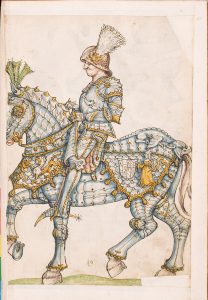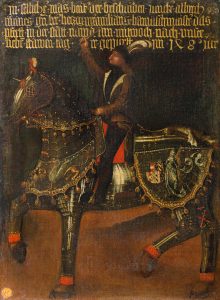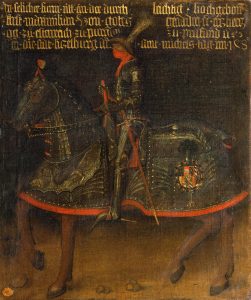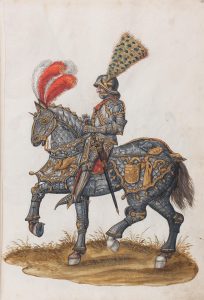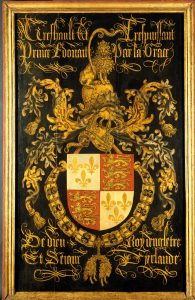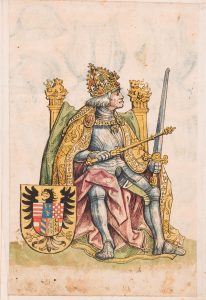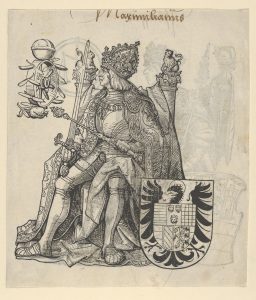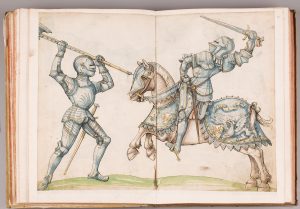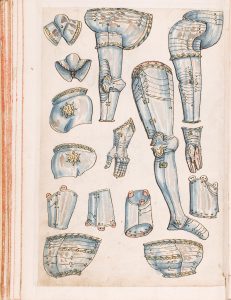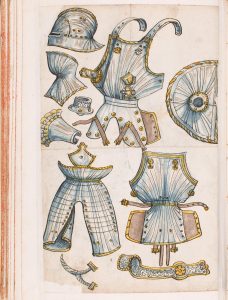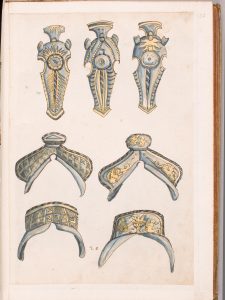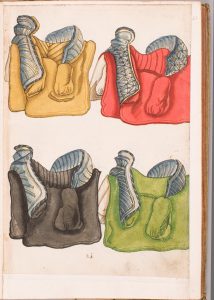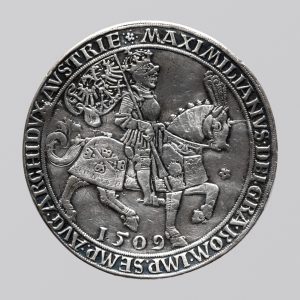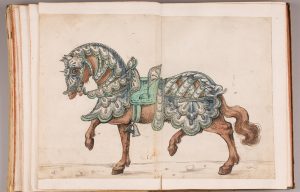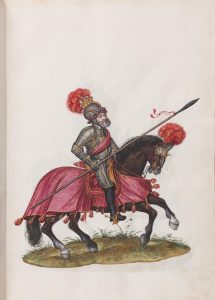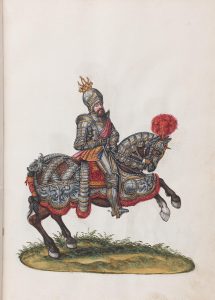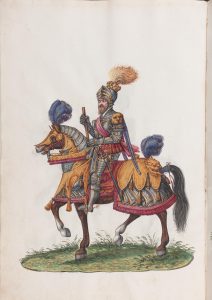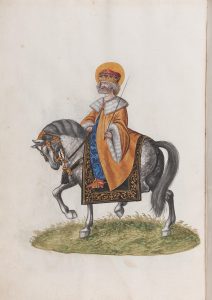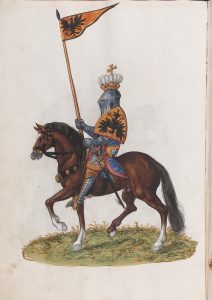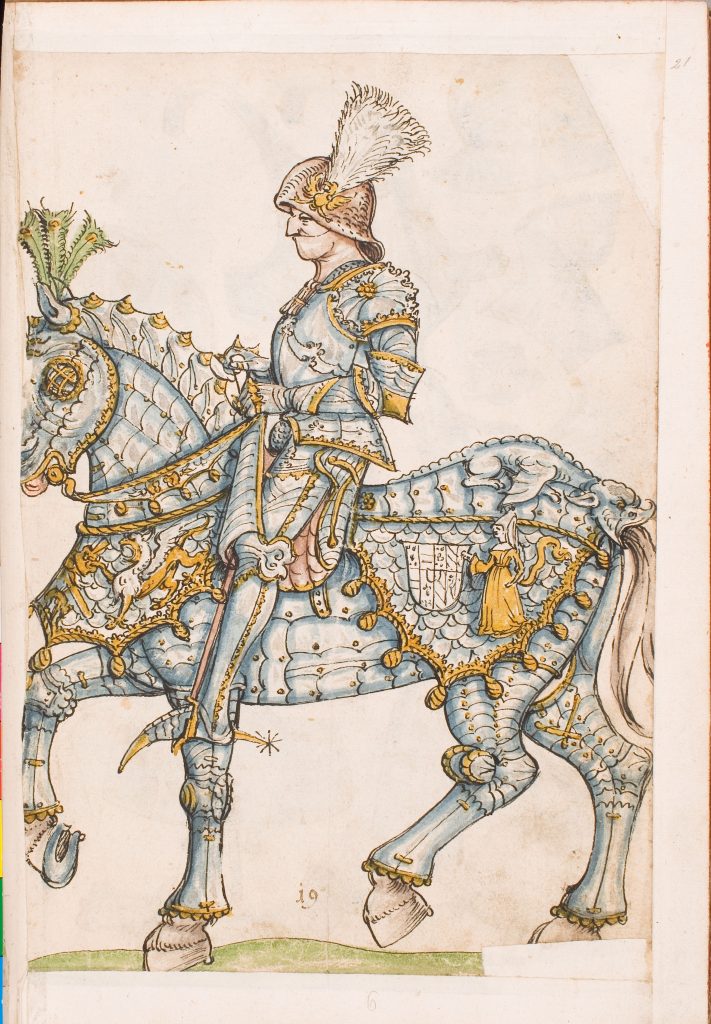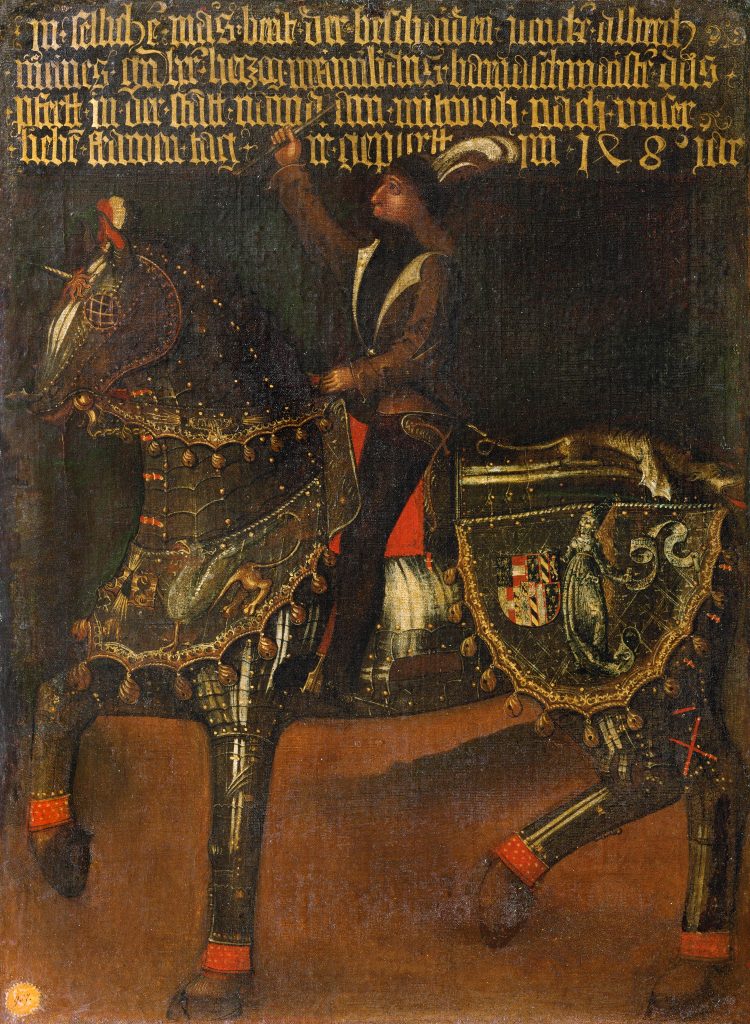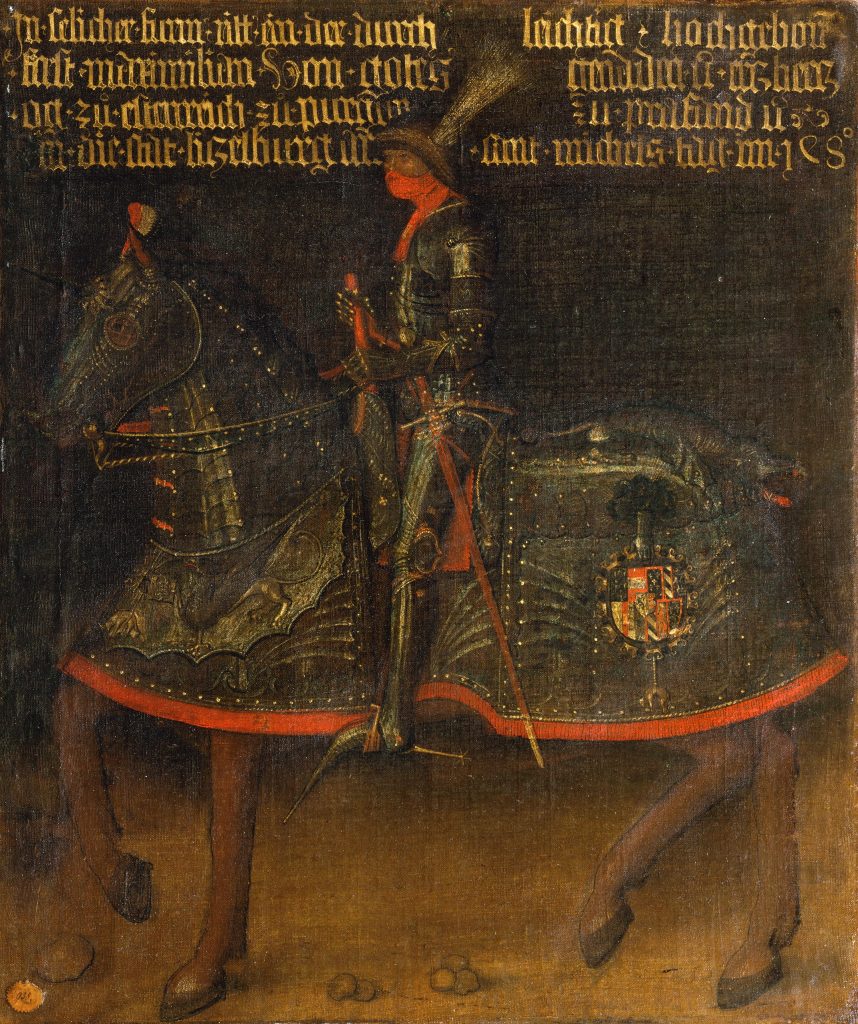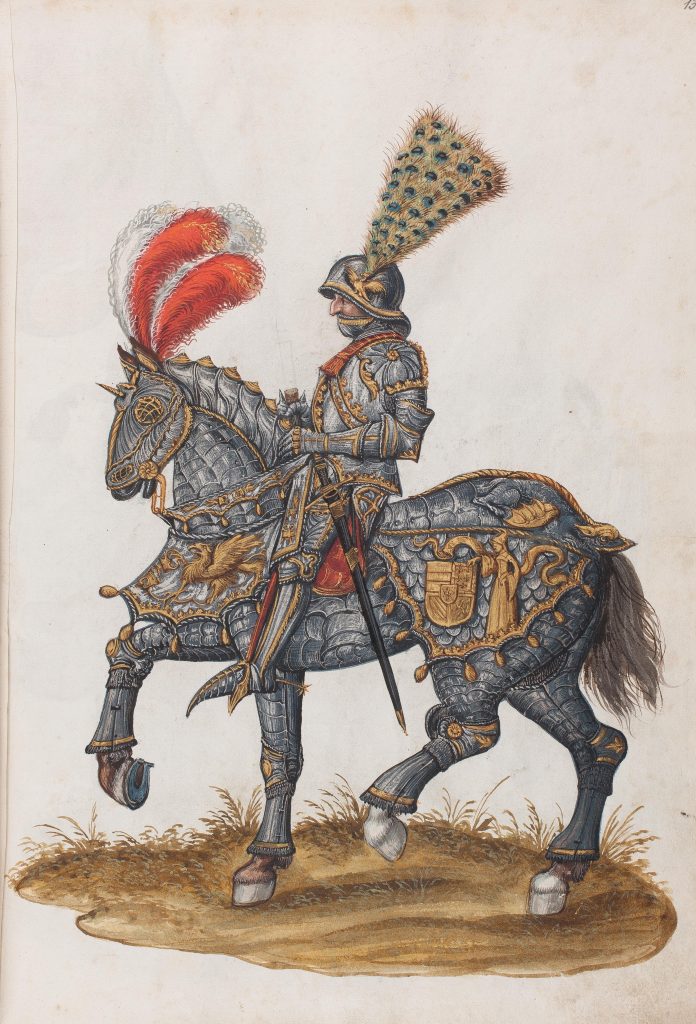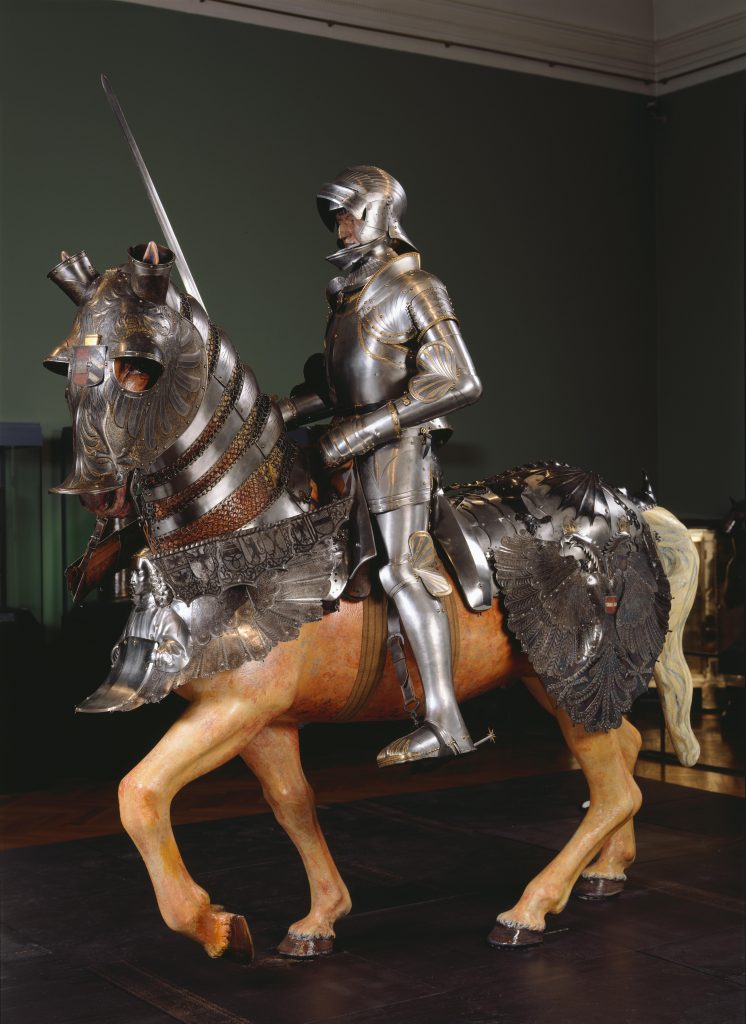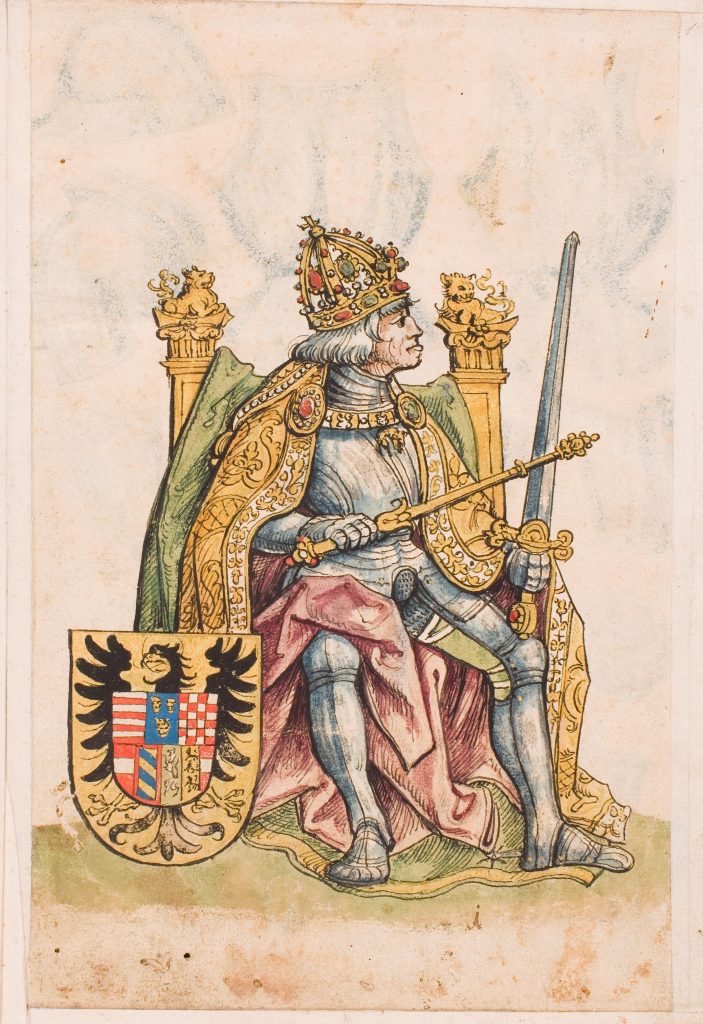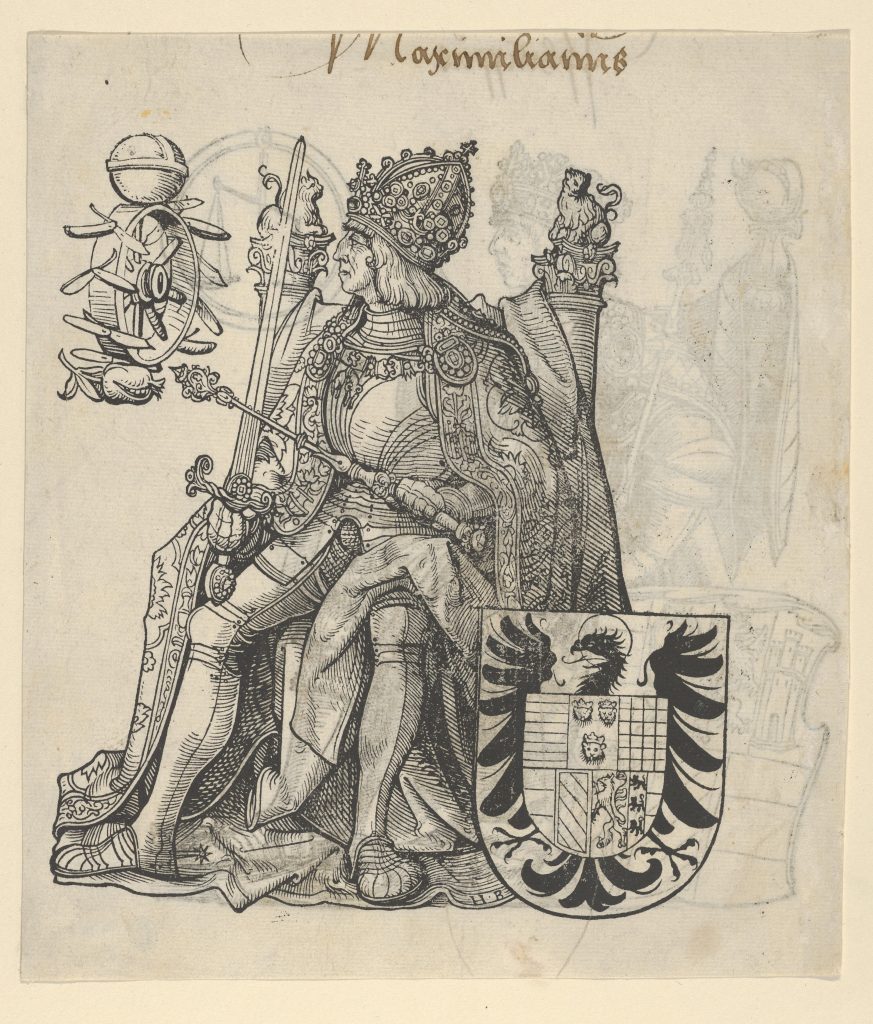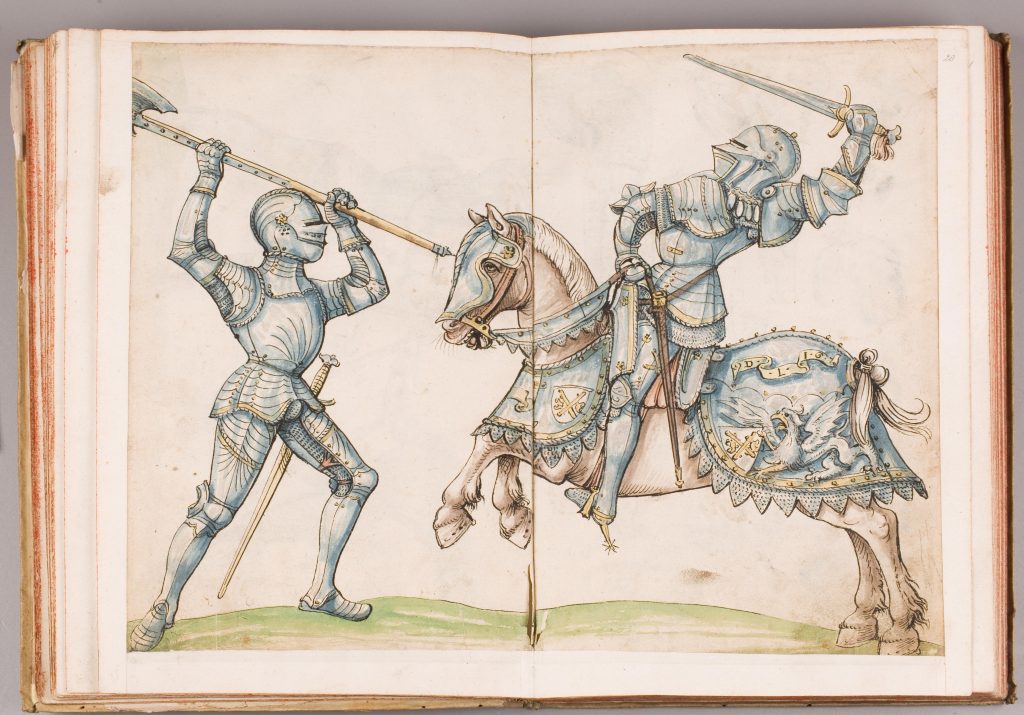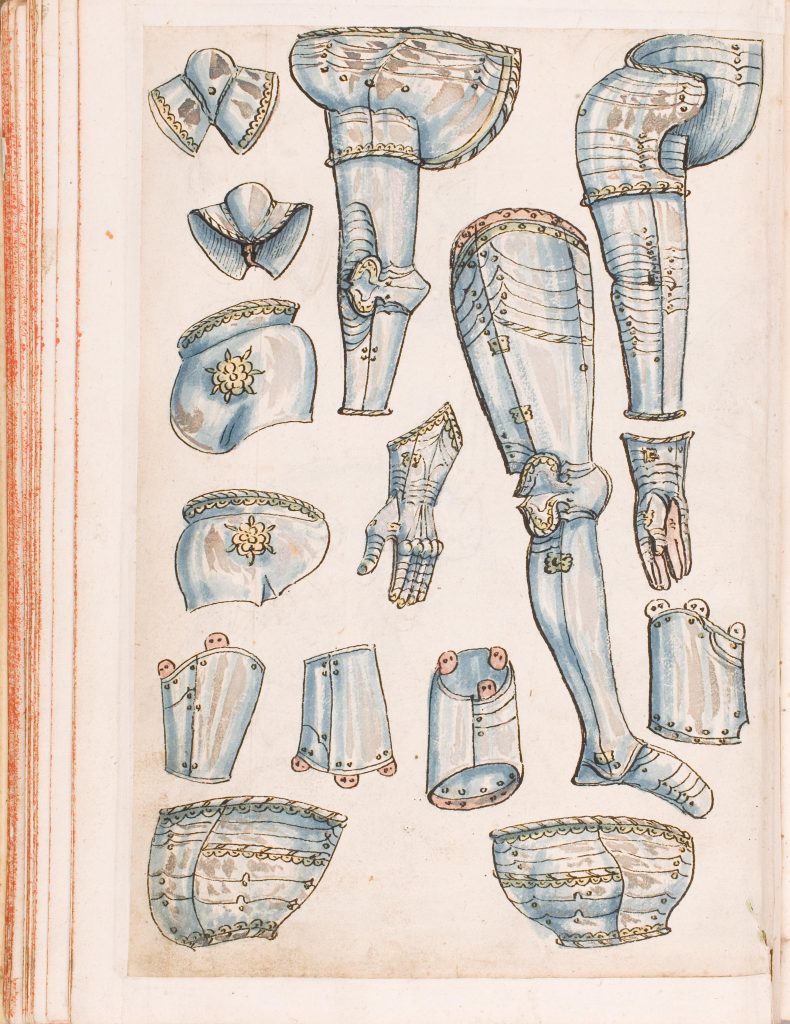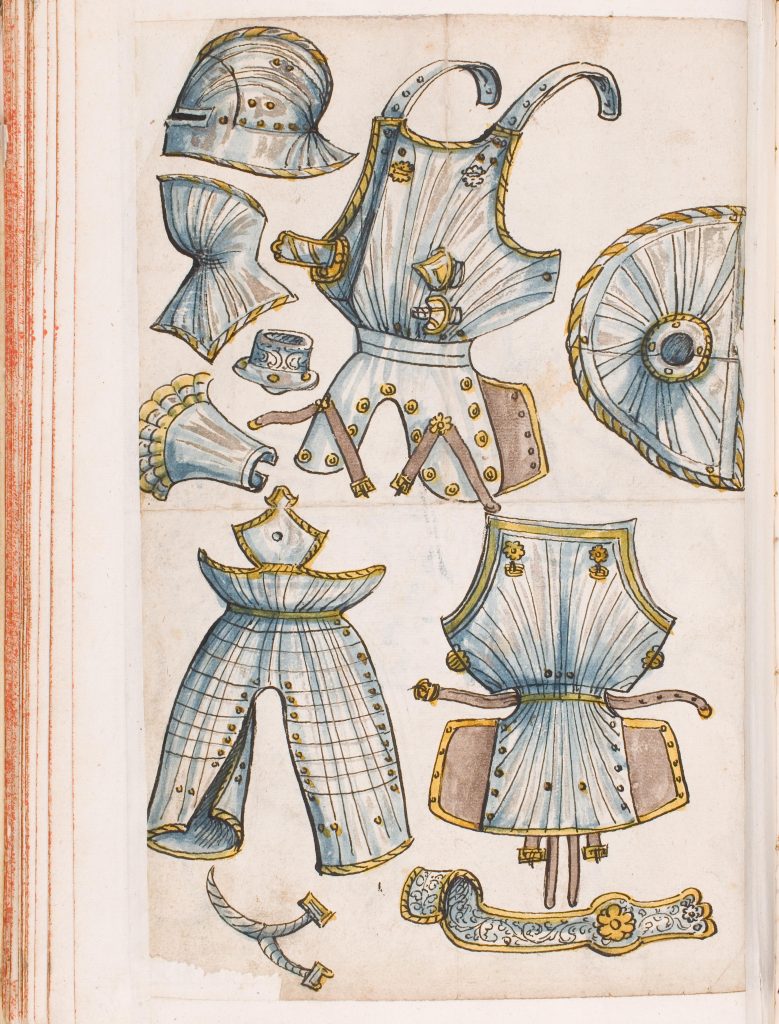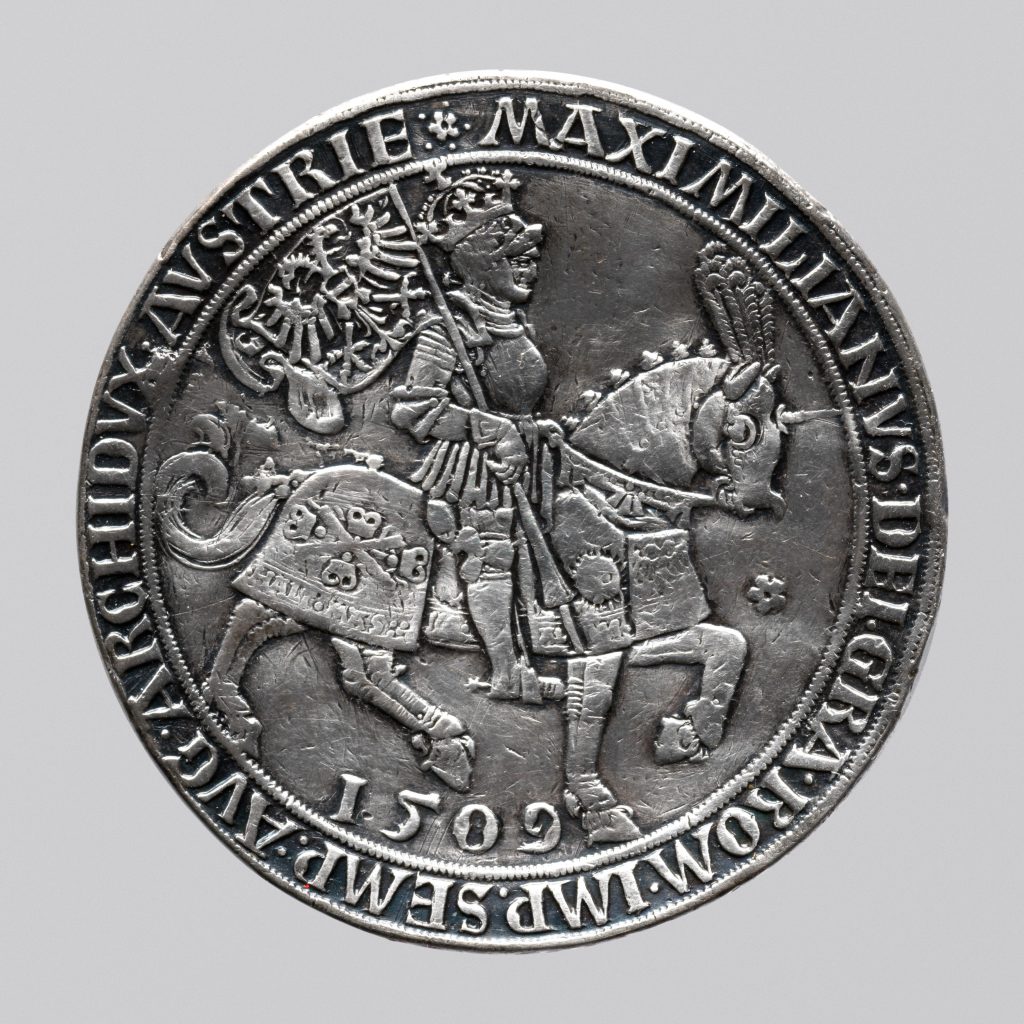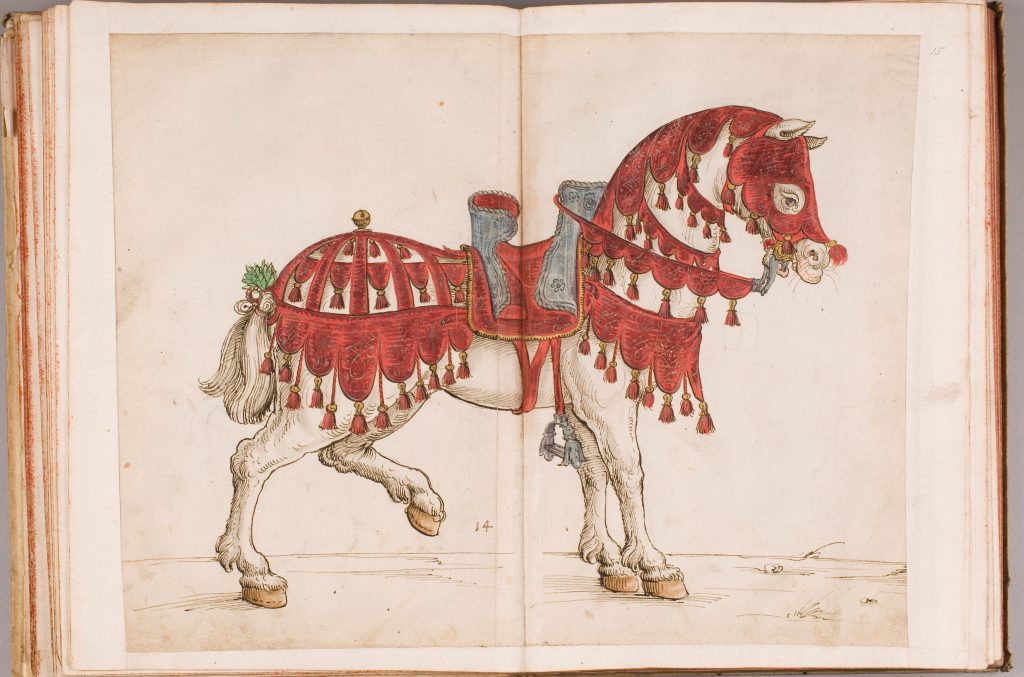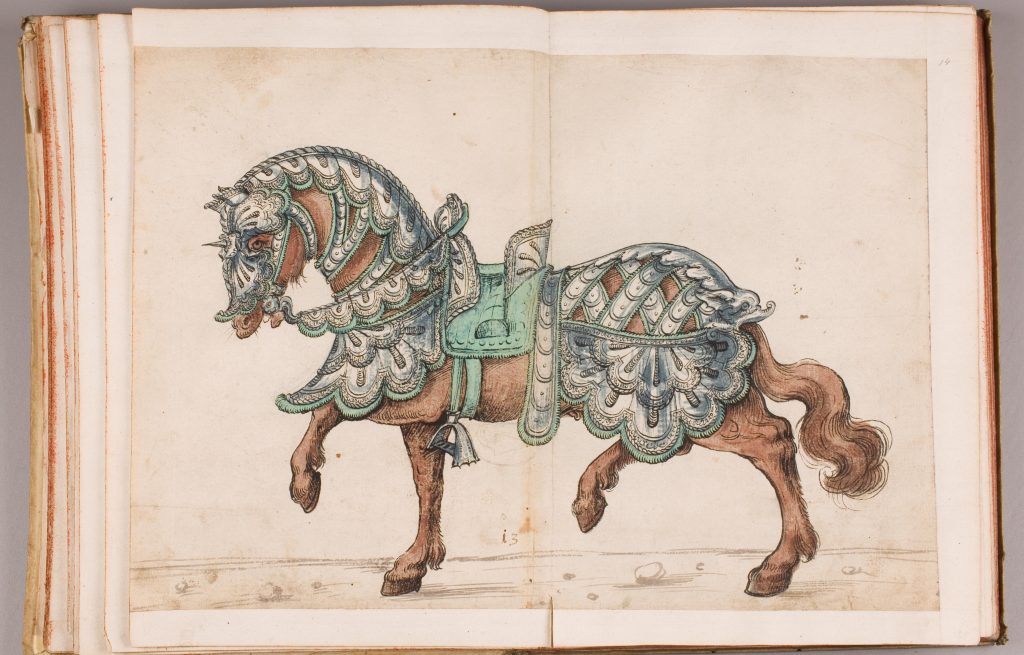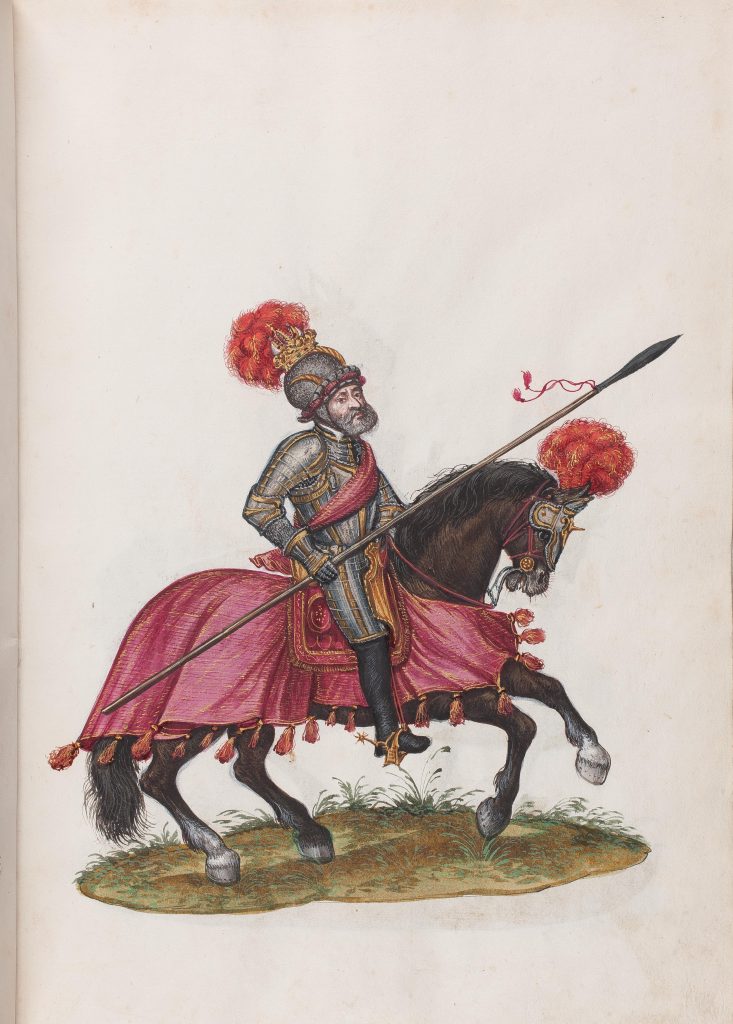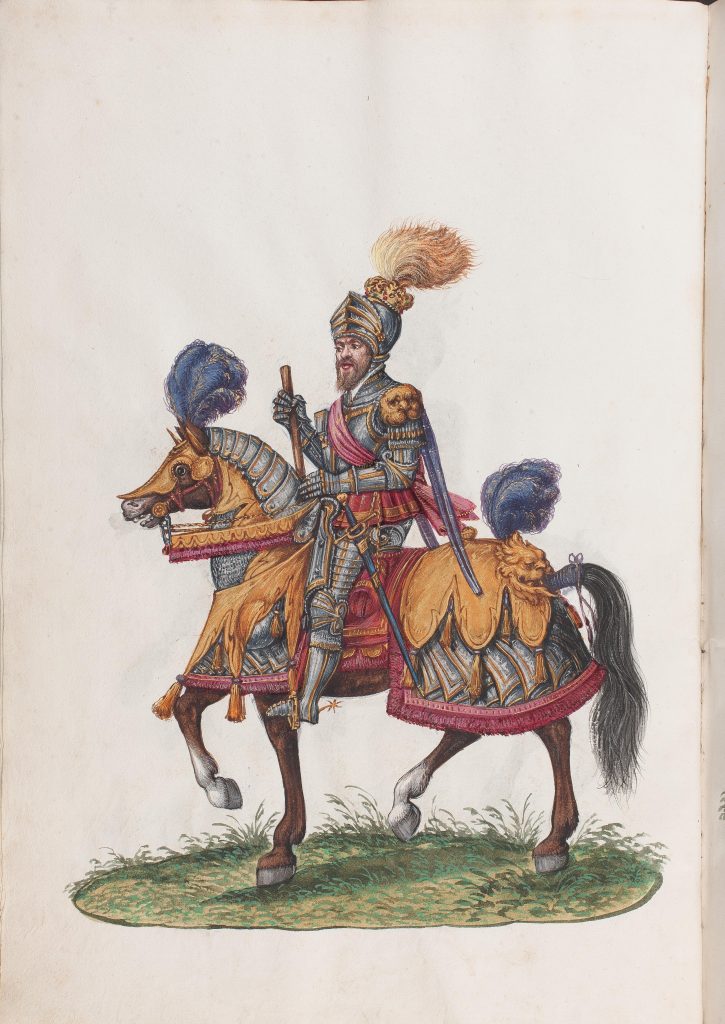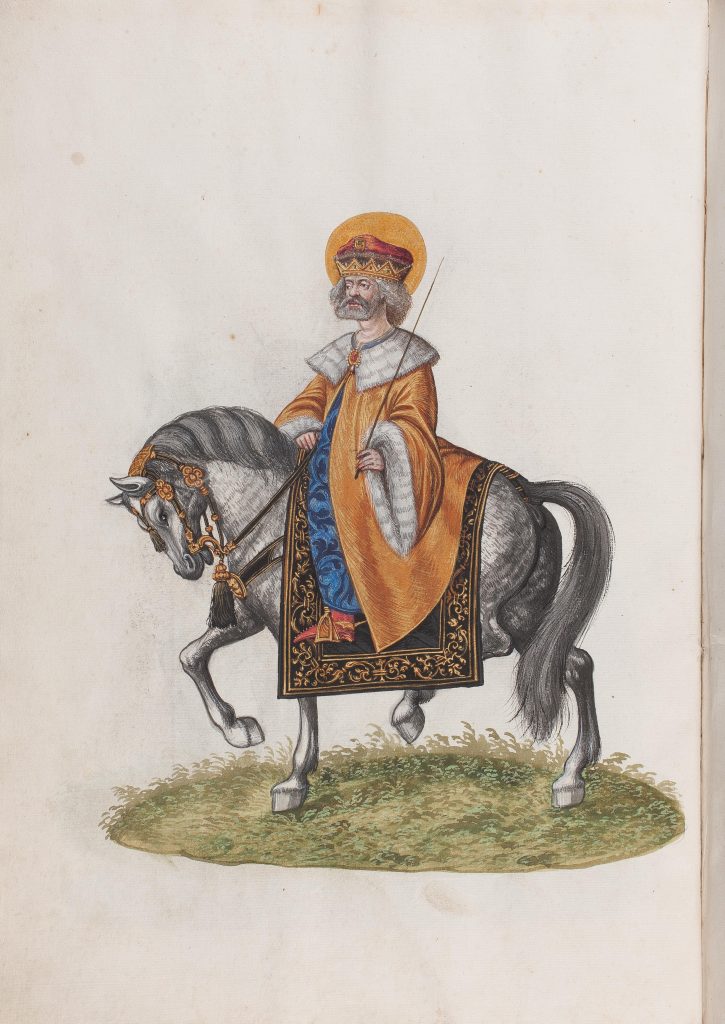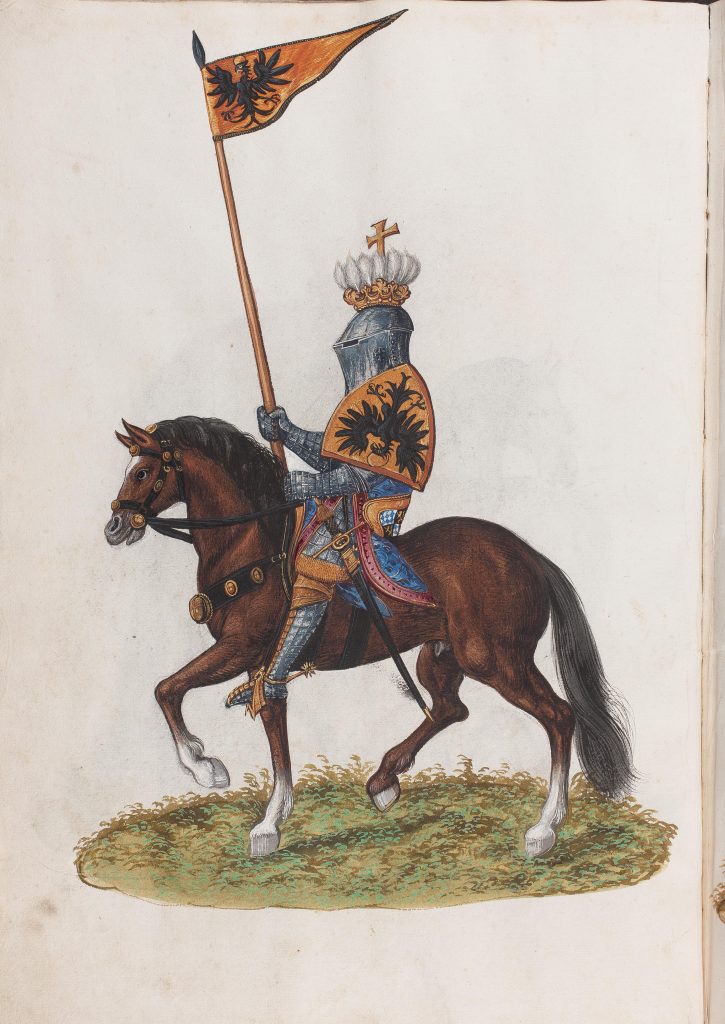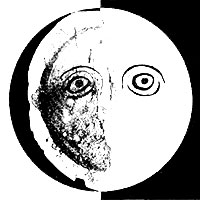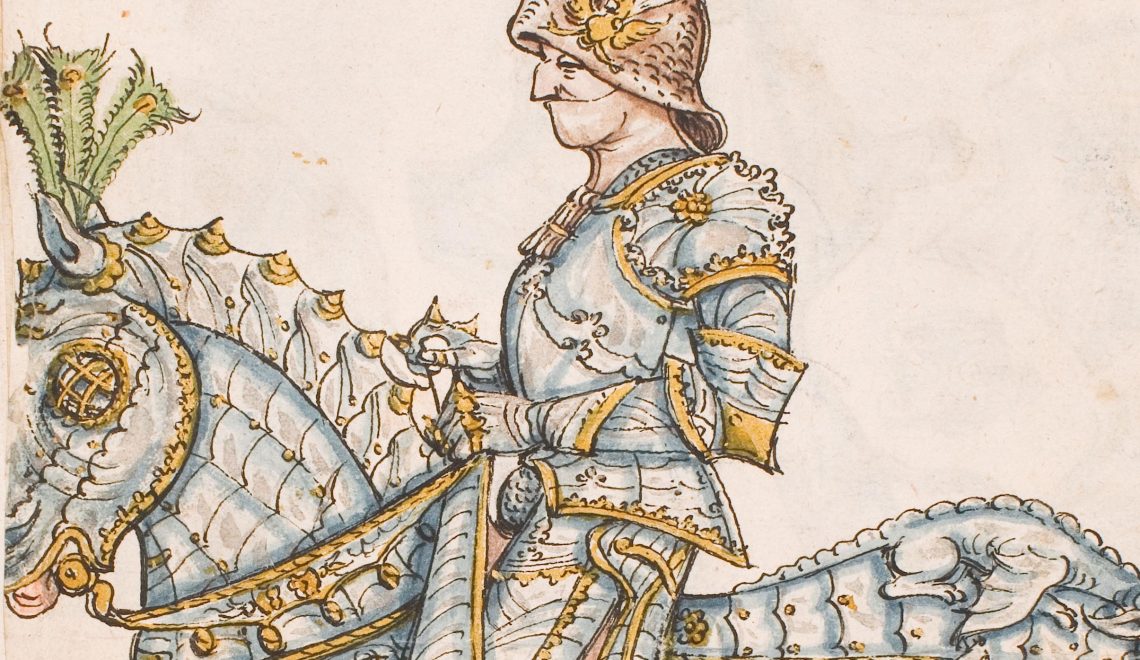
![]()
Abstract
This article examines a lineage of retrospective images that portray Maximilian I as armored Archduke of Austria and Duke of Burgundy, riding a horse that is clad in impressive plate armor from its head to its hooves. These artworks, which span the sixteenth century, participate in the early modern cultures of remembrance that surround Maximilian’s knightly persona and posthumous mythos. The central image of the study is a drawing, created during the 1540s, that is bound into the so-called Thun-Hohenstein Album. This drawing synthesizes two earlier paintings, now in the Kunsthistorisches Museum in Vienna, that represent triumphal entries into the cities of Namur and Luxembourg in 1480. A later image, created in Augsburg around 1575, exactly parallels the drawing in the Thun album, which it may copy. Careful consideration of these images, their meanings and their different contexts of creation and reception, as well as the equine armor that they depict, demonstrates the persistent significance of armor in the early modern cultures of remembrance of the Holy Roman Empire.
Abstract (German)
Dieser Artikel untersucht eine Reihe von retrospektivischen Bildern, welche Maximilian I. als geharnischten Erzherzog von Österreich und Herzog von Burgund auf einem eindrucksvoll ausgerüsteten, von Kopf bis zu den Hufen gepanzerten Pferd reitend zeigen. Diese Kunstwerke, welche allesamt aus dem sechzehnten Jahrhundert stammen, nehmen an der frühneuzeitlichen Erinnerungskultur um die ritterliche Rolle Maximilians und an den posthumen Mythen um seine Person teil. Im Zentrum der Überlegungen steht eine Zeichnung, welche um 1540–1550 datiert und im sogenannten Thun-Hohenstein-Album gebunden ist. Diese Zeichnung kombiniert zwei frühere Gemälde, gegenwärtig in der Sammlung des Kunsthistorischen Museums Wien, welche zwei Triumphzüge durch die Städte Namur und Luxembourg im Jahre 1480 darstellen. Ein späteres Bild, entstanden um 1575 in Augsburg, zeigt dasselbe Motiv wie die Zeichnungen im Thun-Hohenstein Album: Es könnte sich demnach hier um eine Kopie handeln. Eingehende Untersuchungen zu diesen Bildern, ihren verschiedenen Kontexten und Bedeutungen, sowie zu den dargestellten Rossharnischen können die kontinuierliche Bedeutung von Rüstungen in der frühneuzeitlichen Erinnerungskultur des Heiliges Römischen Reiches demonstrieren.
Table of contents
This study, supported by research funding from the Renaissance Society of America and the University of Kansas, was made possible by generous assistance from a network of colleagues and scholars. I am grateful to Tereza Janoušková and the staff at the Uměleckoprůmyslové museum v Praze, as well as to Stefan Krause, Guido Messling, and Ilse Jung of the Kunsthistorisches Museum and Alvaro Soler del Campo of the Real Armería, and to the gracious staff members of the Bayerische Staatsbibliothek and the Herzog August Bibliothek. My colleagues at the Metropolitan Museum of Art have offered invaluable encouragement and insights, and Pierre Terjanian and Markus Sesko each deserve special thanks. I am also thankful for the thoughtful comments provided by the reviewers who offered feedback on this publication. Finally, I am deeply indebted to Anne D. Hedeman and Stephen H. Goddard for their advice and editorial feedback during the early stages of this study.
- Fig. 1: Artist A, Emperor Maximilian I, 1540s, in the Thun Hohenstein Album, Prague, Uměleckoprůmyslové museum v Praze, Inv. GK11572-B, ff. 1r.
Introduction: A Lineage of Commemoration
A drawing (fig. 1) that forms the twenty-ninth folio of one of two codices known as the Thun-Hohenstein albums depicts the future Emperor Maximilian I (1459–1519) as Archduke of Austria and Duke of Burgundy. Clad in resplendent armor in the style of the late-fifteenth century, Maximilian rides a horse that is also fully encased in overlapping steel plates that extend from its head to its hooves. This ink and gouache image was created in Augsburg by an anonymous book painter—who I call Artist A—during the 1540s, but it retrospectively imagines Maximilian’s appearance and that of his armored steed as they processed through Burgundian territories in September 1480. The drawing synthesizes and expands two early sixteenth-century paintings on canvas that were themselves copied by artists in the service of the Habsburg court from now-lost Netherlandish antecedents. One of these depicts the imperial Master of Arms, Albrecht May, riding Maximilian’s armored horse through the city of Namur (fig. 2); the other visualizes Maximilian riding through Luxembourg (fig. 3).
- Fig. 2: Anonymous painter, Albrecht May Riding the Armored Horse in September 1480, circa 1490-1510, oil on canvas, Vienna, Kunsthistorisches Museum, Inv. GG 2375. Photo: KHM Museumsverband.
- Fig. 3: Anonymous painter, Maximilian entering Luxembourg in September 1480, circa 1490-1510, oil on canvas, Vienna, Kunsthistorisches Museum, Inv. GG 2374. Photo: KHM Museumsverband.
The drawing in the Thun album was neither a backward-looking anomaly nor the last vestige of a waning memorial tradition. Around three decades after its creation during the 1540s, another anonymous Augsburg book painter reimagined the composition. Now in the Herzog August Bibliothek, Wolfenbüttel, this image once again presents Maximilian astride the armored horse (fig. 4). Painted around 1575, it is bound within a series of portraits of other Habsburg rulers, allies, and contemporaries. Like the Thun album drawing, which may have served as its precedent or, at least, shared its model, the Wolfenbüttel image combines the discrete triumphal moments that the two paintings depict to construct an impressive, unified vision of armored man and horse.
- Fig. 4: Unknown Augsburg Artist after Artist A, Maximilian riding the armored horse, circa 1575, in Eine Reihe von in Farben zum Theil schön ausgeführten Bildern, Wolfenbüttel, Herzog August Bibliothek, Cod. Guelf. 1.11.2 Aug. 2°, ff. 13r. © Herzog August Bibliothek Wolfenbüttel. Online.
Charles Buttin analyzed these works of art as documents of innovative bards (horse armors) that enclosed the entire animal in steel, which were crafted for Maximilian by the armorers of Augsburg’s Helmschmid family. Ortwin Gamber, Fedja Anzelewsky, and Pierre Terjanian established the relationship between the drawing on Thun album folio 29r, the paintings, and the group of spectacular bards that Buttin identified. The present study builds upon these scholars’ foundations to analyze the potential of these remarkable armors and the retrospective works of art that portrayed them to function as objects of memory.
The striking drawing in the Thun album exists within a pictorial continuum that encompasses images made over nearly a century, from the 1480s through the 1570s. Analysis of the drawing’s antecedents, contexts of creation, codicology within the album, and copies that it generated places the image within a visual tradition that mythologized Maximilian’s exploits and retrospectively celebrated his idealized knightly identity. By considering the meanings resident in spectacular armors for man and horse and tracing their portrayals across miles and decades, this study shows how real events in the ruler’s lifetime were transformed through retrospective art and literature into a chivalric mythos that animated early modern cultures of remembrance.
Representations of Maximilian and his armored steed intersect with an expansive range of visual culture that defined the prince’s mythic persona. Their dates of creation and, in the case of the Thun album, compilation attest to the persistence of this mythos through the sixteenth century and into the 1600s. Like the so-called Ruhmeswerke commissioned by Maximilian himself, the images mythologized his Burgundian exploits and offered viewers opportunities to retrospectively celebrate his idealized knightly identity. By referencing triumphal processions that took place in Netherlandish cities in fall 1480, the paintings encouraged recollection of Maximilian’s assumption of the performative chivalric legacy of his predecessors, the Valois Dukes of Burgundy. When bound within the Thun album, Artist A’s synthesis of these models joined other representations of luxury armors that participated in performances of Habsburg power and attested to the skill and ingenuity of Augsburg armorers. Similarly, the Wolfenbüttel image placed Maximilian within a depicted panoply of knightly figures. The surrounding leaves of the codex contain mounted portraits of not only his predecessors, but also his successors, each of whom is presented in glittering armor and imperial finery. Tracing images that depicted Maximilian and his armored steed reveals how the military, political, and economic turmoil that Maximilian and his first wife, Mary of Burgundy (1457–1482), faced in 1480 were transformed through retrospective art and literature into the chivalric myth of the so-called “Burgundian Experience.” Further, contextualizing each image within its historical moment demonstrates how Maximilian’s memory was reshaped by successive generations of artists, viewers, and collectors.
The group of images under investigation memorialize demonstrations of Maximilian’s power as Duke of Burgundy that took place at a time and place about which scholarship on the Burgundian-Habsburg court and its visual language remains sparse. Andrew Brown describes Mary of Burgundy’s short reign, which began in 1477, and the decade of strife following her death in 1482 as “damaging years for all kinds of spectacle.” However, analysis of the long pictorial lineage that depicted the entries of fall 1480 alongside consideration of the armors deployed during the events demonstrates the persistence of princely spectacle and its significance in this politically precarious time. In turn, investigation of the patterns of transmission and adaptation that carried images of the armored prince and horse forward in time reveals the persistent commemorative potential of such images and the associations that they invited.
A Marvel in Context: The Netherlandish Entries of 1480
This article’s focus is neither the precise identification of surviving armors that the interrelated images may portray nor deep historical analysis of the moment in 1480 when the entries took place. Rather, this study seeks to consider the how retrospective images of the spectacularly armored horse participated in the shifting Erinnerungskulturen that constructed and reconstructed Maximilian in the minds of early modern viewers. However, an overview of the entries and exploration of the exceptional nature of the armors deployed in them expose the later artworks’ original referents and establish important foundations for the images’ analysis.
On St. Michael’s Day (September 29), 1480, Maximilian rode into the newly retaken city of Luxembourg. Days earlier, likely on or around September 13, his Master of Arms, Albrecht May, had ridden the armored horse into the city of Namur. These entries, along with later representations of Maximilian and his retinue, disguised the grim political realities faced by the prince, his bride, and the Burgundian state in 1480. Indeed, the processions and splendid armors were themselves visual propaganda meant to reinforce the construction of the new Duke of Burgundy as an impermeable hero, surrounded by wealth and favored by fortune.
Following the death of Duke Charles the Bold of Burgundy (1433–1477) at the hands of the combined forces of France, Lorraine, and the Swiss Cantons on the battlefield at Nancy, the cities of the Burgundian Netherlands saw an opportunity to reclaim the autonomy that decades of increasingly centralized ducal power had wrenched from them. Mary, Charles’s heir, was taken captive in Ghent. Under duress, she signed the Great Privilege, which reestablished the political and commercial liberties that her father and grandfather, Philip the Good (1396–1467), had wrested from the powerful cities of Ghent, Bruges, and Ypres. Other cities followed suit in reclaiming their historic levels of relative autonomy.
After his arrival in 1478, Maximilian’s cultivation of power as Duchess Mary’s consort was met with suspicion or outright rejection by many of his subjects. He did not recognize the necessity of compromise with the leading citizens of the Netherlandish cities, and he underestimated the power of urban alliances between the bourgeoisie and powerful guilds. These political and economic missteps contributed to what Haemers called the “social bankruptcy” of Maximilian’s Netherlandish court. However, the entries of 1480 and their representations visualize the duke’s attempts to rebuild his social and symbolic capital. By adopting the magnificent, knightly identities that defined his Valois predecessors, Maximilian sought to reposition himself at the center of his fragmented Burgundian inheritance.
Even as Netherlandish cities redistributed the balance of power, Mary’s sovereignty was threatened from the south by Louis XI of France (1423–1483), who used the prohibition of female inheritance under Salic Law to claim the Duchy of Burgundy and its possessions for himself. By annexing the ancestral French duchy and invading Picardy, the Counties of Vermandois, Artois, Hainault, and Namur, and the Duchy of Luxembourg, Louis sought to reclaim territories that—he argued—had only been held in appanage by his Burgundian cousins. Louis’s French commanders took advantage of rebellions in Flemish, Brabantine, and Dutch cities. When, in spring 1480, Maximilian rode north to respond to uprisings in Guelders, Zeeland, and Holland, strategically placed French troops took the cities of Namur and Luxembourg. The two cities, which had only been Burgundian territories since their acquisitions by Philip the Good in 1421 and 1441, were strategically important. Both municipalities were known for their strong walls, which had been strengthened during the Hundred Years’ War, and each city owned a sophisticated arsenal of canon and other artillery that would benefit whomever held it. The recaptured cities were also venues for political accord during fall 1480. Maximilian’s efforts to forge an alliance with England came to fruition on August 1, 1480, and, on the twenty-first of that month, Louis agreed to a cease-fire. After retaking Luxembourg with the help of fresh troops sent by his father, Emperor Friedrich III (1415–1493), Maximilian remained in the region throughout the fall in order to solidify his power there, and, while he resided in these territories, the previously rebellious factions of Holland, Zeeland, and Guelders sent emissaries to pay him homage. Thus, the images analyzed in this study refer to a brief period of celebration and peace, prior to the resumption of conflict in 1481, and the chaos that followed Duchess Mary’s death in 1482.
“To Arm a Horse Allover”: Innovative Armors as Performances of Power
On February 8, 1480, Maximilian summoned the armorer, Lorenz Helmschmid (active circa 1467–1515/16), who had served Emperor Friedrich III as court armorer since at least 1477, to the Low Countries from Augsburg. The Burgundian court records mention “Lorenz of Augsburg, armorer to my aforementioned lord” at least three times, and he was paid upon his arrival for “bards of steel, cuirasses, clothes of test (armors tested against projectiles), armors for the legs, and other pieces of armor.” Lorenz remained in the Low Countries until May, 1481, and was therefore present at the Burgundian court during the period when the entries of September 1480 took place. Indeed, prior to his departure in 1481, he was paid an additional 1,575 livres for many parts of a garniture and other “clothes of war,” especially “some bards forged of steel for armor of test, collar, shaffron (defense for a horse’s face), belly, and legs and various other parts serving to arm a horse allover, done by him with 800 florins of gold trim,” plus a 56-livre tip for his skill.
The bard that the painting of Albrecht May, the Thun Album and the Wolfenbüttel codex depict may have been the same horse armor described in the record of payment to Lorenz Helmschmid, but it does not survive. Though no complete equine armors with articulated legs have been preserved into the present day, depictions, written accounts, and fragmentary portions of armor attest to the roles of these exceptional objects within Maximilian’s self-presentation and diplomatic policy. Surviving pieces of a horse armor of similar date and artistic merit made for Emperor Friedrich III in 1476 or 1477 provide a glimpse of the splendor of the bard deployed in 1480 (fig. 5). The elements include a sculpted peytral (defense for the horse’s chest and shoulders) in the form of angel, whose wings echo the screaming griffins that adorn the peytral depicted in the Thun drawing and the painting of May. The dragon-shaped tailpiece of this bard is so strikingly similar to the tailpieces depicted in the later images of Maximilian’s 1480 armor that Anzelewsky posited that this component could have been borrowed from Friedrich’s earlier armor and taken north to the Burgundian Netherlands.
- Fig. 5: Lorenz Helmschmid, Bard made for Friedrich III, 1477 (displayed with later armor for man), Vienna, Kunsthistorisches Museum, HJRK A. 69. Photo: KHM Museumsverband.
In its most luxurious iterations, horse armor did far more than protect an expensive and extensively trained steed. It transformed the animal’s body into a moving sculpture and a communicative surface upon which to inscribe the iconography of power. In the case of the bard now in Vienna, the crupper plates that encase the horse’s flanks form imperial double eagles that are enlivened by etched feathers and emblazoned with an escutcheon bearing the arms of Austria. The corresponding crupper shown in images of the 1480 entries uses the marshalled heraldry of the Habsburg and Burgundian dynasties, supported by a figure that resembles the duchess herself, to declare the consolidation of Mary and Maximilian’s power.
Like the heraldic plates that adorn the horse’s flanks in images of the 1480 entries, the peytral that encloses its chest proclaimed Maximilian’s status as the leader of the Burgundian Order of the Golden Fleece, signified by the gilded Crosses of Saint Andrew, fire steels, and fleece. As Anzelewsky pointed out, the elements of the bard, like most garnitures (or matching sets) of armor, were interchangeable. Indeed, a diplomatic letter written by the Venetian, Andrea de Franceschi, chronicles a procession through Strasbourg on August 31, 1492 in which Maximilian may have recombined parts of the equine armor depicted in the paintings and by Artist A with the imperial eagle cruppers crafted for his father in 1477. Franceschi describes a “horse armored from head to foot—an extremely glittering sight!” According to the letter, the animal’s breast was emblazoned with two griffins and on each of its flanks was the imperial eagle.
Within the context of Burgundian courtly spectacle, a bard that encased the entire horse was as much a wonder of innovation and artistic skill as it was a declarative collection of signs and a practical protective shell. The miraculously articulated metallic exoskeleton that Lorenz Helmschmid created echoed spectacular feast entertainments, called entremets, that combined rich and innovative objects with live performances to delight guests at Burgundian feasts and festivities. As Normore has shown, entremets enacted a conflation of inorganic wonders and living bodies, and their designers and audiences delighted in the strangeness and novelty of their imagery. Like processions, entremets also frequently blurred the boundaries between spectator and participant. Movement, sound, and sumptuous materials were often defining characteristics of each mode of spectacle.
The Mémoires of the Burgundian chronicler, Olivier de la Marche, describes the ways that entremets combined material splendor and technical ingenuity with human performances. For example, he exalts in describing “an artifice” of a white stag, ridden by a real boy, that seemed to sing as it walked among the guests gathered at the Feast of the Pheasant, held in Lille in 1454. The stag—presumably comprised of costumed performers, perhaps operating mechanical parts—delighted la Marche and other diners as its material performance combined with that of the living boy, as both raised their voices in song. Another entremet at the same feast included a horse, covered in red silk and ridden by two sumptuously dressed and masked trumpeters seated back to back, which processed through the hall backward. As in the initial introduction of the entremet of the white stag, la Marche’s description leaves his reader unsure whether the back-stepping steed and his riders were real or fabricated.
The living horse that pranced through Namur on September 13, 1480 enclosed within a carapace of flexible steel plates that transformed its body into a scaled beast adorned with the insignia of Burgundian power finds a compelling parallel in what Normore calls the “object-performances” of the entremet. Lorenz Helmschmid’s innovative armor would, like an automaton or other technological wonder, have been considered a marvel by Burgundian viewers. The spectacle of the steel-clad steed processing through Namur and—shortly thereafter—the splendidly armored duke himself riding through Luxembourg would therefore have impressed not only the people of those cities, but also courtiers and officials in Maximilian’s own train who may not have supported the new duke whole-heartedly.
Albrecht May’s progress through Namur on the armored horse would have evoked still more layered associations with courtly spectacle. The Master of Arms’ arrival on September 13, 1480 preceded his lord’s by some days since Maximilian was in the town of Wavre from September 16-17, and did not meet with his household in Namur until September 18. Thus, May’s entry into the city heralded the prince’s approach in a practice that echoed the arrival of tournament participants’ horses—ridden by pages—and significant pieces of armor, such as helms, prior to the entrance of the knights themselves. Writing around 1460, King René d’Anjou (1409-1480) described how a prince’s steed should precede his entry into a city where a tournament would be held in his treatise, the Livre des Tournois. René states:
“That is to say that the destrier of the prince . . . who is captain of the knights and squires who accompany him ought to enter the city first, covered with the device of the captain and with four escutcheons of the captain’s arms on the four limbs of the horse, and the horse’s head decorated with ostrich feathers, and on the horse’s neck a collar of bells, and in the saddle a very small page, as best pleases him.”
As Buttin and Anzelewsky suggested, the armored steed that strode through Namur functioned as a moving banner whose glittering presence heralded the entry of its master. The armor that encased the horse’s entire body not only presented a marvelous spectacle that was reminiscent of the “object-performances” of Burgundian courtly entremets; it also announced Maximilian’s knightly identity even in his absence. The Livre des Tournois, which was familiar to members of the Burgundian court, including Maximilian, also demonstrates the metonymic nature of armor. In addition to René’s description of the entry of the tournament captain’s horse, the author relates how the crested helms of the tournament participants should be brought by their squires to a cloister or banqueting hall. There, the helms and crests served as metonyms for their wearers that could be symbolically judged and even cast down in punishment if a knight’s conduct was deemed unchivalrous. The Livre des Tournois’ emphasis on the associative processional impact of recognizable armors emblazoned with heraldic signs of their owner’s identities not only supports Anzelewsky’s claim. It also suggests new ways of understanding how the armored equine spectacle that took place in September 1480 visually declared Maximilian’s assumption of leadership in the city of Namur and reclamation of Burgundian lands from French incursions.
No surviving equine armor approaches the technical and visual ambition of the articulated bard, and the Helmschmids are the only armorers known to have created matrixes of steel plates flexible enough to encase a horse’s entire lower body as it moved. Indeed, this type of armor became associated with Maximilian, who continued to commission bards that covered horses’ legs and bellies to arm his own steeds and also as diplomatic gifts to forge alliances and demonstrate Habsburg power. For instance, on July 21, 1515, the emperor presented “two coursers all covered with steel to the fetlocks and the belly, save in the spurring place” to Sigismund I, King of Poland (1467–1548). Thus, articulated bards were not only central to Maximilian’s performance of status, but artworks whose integral association with Habsburg patronage of luxury armors signified their owner’s alliance with the imperial court. Though Lorenz’s son, Kolman Helmschmid (1471/72-1532), seems to have made fully articulated bards based on his father’s invention, their disappearance from imperial armor commissions coincides with Lorenz’s death as well as the waning years of Maximilian’s own life.
“In this way…he graciously rode”: The Vienna Paintings
Despite their creation during the early sixteenth century as copies after lost late fifteenth-century originals, the two canvas paintings now in Vienna call out to the viewer, claiming authenticity as eyewitness impressions of the Netherlandish entries of 1480. One canvas, which portrays Maximilian riding a horse barded in a style common during the late fifteenth century bears an inscription in Early New High German that declares, “In this way, his Highness, Prince Maximilian, by God’s grace Archduke of Austria, of Burgundy and Brabant graciously rode into the town of Luxembourg on Saint Michael’s Day in 1480.” The armor that Maximilian wears in this painting represents the apex of the armorer’s art during the period. His fluted cuisses (thigh defenses) elongate his legs, an effect complemented by the pointed sabatons (foot defenses) on his feet. Maximilian’s face is partially covered by a red hood or fabric-covered bevor (chin and throat defense), and he wears a fabric-covered sallet (helmet) or a hat that mimics its popular form. Many lames (overlapping, articulated plates) of the prince’s armor are edged in gilt brass bindings that are punched and chased to form rows of delicate fleurs-de-lys. Other elements of the armor, including the lames of the backplate, breastplate, and thigh defenses, terminate in filigreed punch work whose scrolling forms seem to dissolve the hard surfaces of steel into lace. The horse that prances through the painting wears a bard that covers its head, neck and upper body from chest to flanks.
The companion painting depicts an event that took place weeks earlier than Maximilian’s entry into Luxembourg, though its inscription seems to reference its pendant or other images in a now-lost series of which the paintings may have been a part. The inscription states, “Similarly the humble lord Albrecht, master of armor to my gracious lord, Duke Maximilian, rode the horse into the town of Namur on the Wednesday following the day of The Birth of the Virgin in the year 1480.” Thus, through the interplay of image and text, the canvas melds imagery that seems to have been copied from a now-lost Burgundian source with claims to eyewitness knowledge and personal affiliation with the exalted subject.
The canvas visualizes May riding a horse whose body is completely sheathed in flexible plate armor from head to hooves. The armorer has transformed the steed into a fantastically scaled hybrid beast. The peytral is etched and embossed with screaming griffins lifted from the symbolic language of the knightly Order of the Stoll and Jar. The beasts flank the insignia of Burgundy and the Order of the Golden Fleece: the Cross of St. Andrew and sparking fire steels. On the cruppers, the sculpted and etched figure of a young woman, clad in the high-waisted gown and pointed hennin headdress popular at the Burgundian court, holds a shield with the combined arms of Habsburg and Burgundy, seemingly endorsing the union of the two houses. Perhaps this image represents Mary of Burgundy, on whose behalf Maximilian fought to maintain Burgundian ducal power in the Low Countries and dispel French incursions into their territories.
Buttin attributed these paintings to the Burgundian court painter, Pierre Coustain (active circa 1453-1487), based on records of Coustain’s presence in Luxembourg alongside Maximilian in 1480. Though subsequent publications have repeated this attribution, no known evidence joins this circumstantial information to firmly identify the paintings as copies after Coustain. However, comparative analysis of work associated with Coustain’s circle does reveal how artists in the service of the Burgundian court communicated meaning through representations of martial material culture. The Vienna canvases’ dark backgrounds, meticulous attention to luxurious stuffs such as metal and fabric, and incorporation of tituli echo the palette and composition of armorial paintings for the Order of the Golden Fleece that are attributed to Coustain or his workshop. For instance, these characteristics appear in the armorial panel representing King Edward IV of England (1442-1483) for the order’s meeting in s’Hertogenbosch in 1481 (fig. 6). The heraldic tournament helm, crested with a crowned lion and etched with the Cross of St. Andrew and fire steels, as well as the illusionistic collar of the order exemplify Burgundian painters’ deft deployment of objects as signifiers of knightly identity.
- Fig. 6: Attributed to Pierre Coustain (or possibly copied after him), Arms of Edward IV of England as Knight of the Golden Fleece, 1481, oil and gold leaf on panel, Amsterdam, Rijksmuseum, SK-A-4641.
The Thun Album: Codicology, Collecting, and Commemoration
The drawing on folio 29 of the Thun album reconstructs the image of Maximilian and the armored horse in its most awe-inspiring iteration, with both rider and steed fully encased in steel. This drawing and the constellation of images within which it was bound expose memorialization of the Burgundian-Hapsburg legacy, and of Maximilian I in particular, as a unifying theme of the album. Examination of the images that surround this drawing also identifies patterns within the anonymous compiler’s arrangement of the album that suggest interpretive connections between the works of art. The Thun album’s depictions of recognizable armors that were preserved in Habsburg familial collections and imperial armories established the album as a well-known source for modern historians of arms and armor from its first publication in 1888. Although previous studies have focused on connecting the album’s meticulous visualizations of particular armors or types of armor to surviving objects, there has hitherto been no substantial investigation of the drawings’ representation of armor and armored bodies with the larger contexts of courtly pageantry and its commemoration. While these exceptional armors are indeed important examples of the smith’s art, Artist A’s drawing and the artistic continuum in which it exists situate them within the broader context of princely processions and their lasting echoes in pictorial media.
The Thun album is one of a pair of volumes that contain drawings of armor and related imagery. The codices’ provenance between their compilation in early seventeenth-century Augsburg and their entry into the baronial library of the Thun-Hohenstein family at Schloss Tetschen (Děčín) in Bohemia during the eighteenth century remains unclear. Though the Thun album was long thought to be a sketchbook created by the Helmschmid armorers themselves, recent analyses have revealed it be a heterogenous bound collection of retrospective images that include work by at least eight artists. On average, the pages, many of which have been trimmed, measure 307mm high and 220mm wide. All of the eighty-one folios were once loose sheets; these were glued onto the tips of short leaves to make the volume’s nine quires. Elaborate, double-eagle watermarks that appear on the short tips along the gutter, on the guard strips that stabilize and extend the outer, top, and bottom edges of some pages, and on the front and back flyleaves suggest that the codex’s current form—and therefore its compilation—dates to the first quarter of the seventeenth century.
Though the collection of 112 drawings includes images created as early as the 1470s and as late as the 1590s, 101—a significant majority—originated in Augsburg between the late 1530s and late 1550s. These mid-sixteenth-century images, all executed in ink and gouache, highlighted with shimmering metallic washes, form two distinct sets. One of these, a group of sixty-one drawings on paper used in Augsburg primarily during the 1540s, appears to have been executed by a book painter (Artist A) familiar with both armor and its depictions in artworks produced for Emperors Maximilian I and Charles V (1500–1558). Thirty of Artist A’s drawings depict surviving armors crafted by the Helmschmid workshop and many more of his images resemble their distinctive work. Most of the drawings in Artist A’s group retrospectively portray armors made from the 1480s through the 1520s, during and immediately after Maximilian’s lifetime. A second set of forty drawings bears many of the same watermarks and was likely executed in Augsburg during the 1540s or 1550s. This group contains less precise, somewhat clumsy drawings by another anonymous artist (Artist B). Artist B’s images seem to copy images of armor owned by Emperor Charles V and recorded in his Inventario Illuminado, an illustrated inventory of his possessions drawn up in Augsburg between 1544 and 1558.
The first five quires of the album contain primarily armored figures and barded horses, while its last four quires comprise mostly drawings of disassembled pieces of armor arrayed across the page. In the first quire, the first four rectos drawn by Artist A depict four seated portraits of princes of the house of Habsburg: Emperors Maximilian I (fig. 7) and Charles, Louis, King of Hungary (1506-26), and Philip the Fair, Duke of Burgundy and King of Castile (1478-1506). These drawings are based on woodcuts from the Genealogy of Maximilian I (fig. 8), created by Hans Burgkmair the Elder (1473-1531) between 1509 and 1512. Because Burgkmair’s Genealogy never circulated outside of the imperial court or his immediate artistic milieu in Augsburg, it is likely that Artist A had access to one or both of these circles. Furthermore, these four princely portraits form a kind of pictorial preface to the first quire’s images of figures clad in sumptuous armors for the tournament and procession.
- Fig. 7: Artist A, Emperor Maximilian I, 1540s, in the Thun Hohenstein Album, Prague, Uměleckoprůmyslové museum v Praze, Inv. GK11572-B, ff. 1r.
- Fig. 8: Hans Burgkmair the Elder, Maximilian I, from the Genealogy of Emperor Maximilian I, 1509-12, woodcut (first state), New York, Metropolitan Museum of Art, 39.92.1a.
Like his vision of Maximilian on horseback, Artist A’s princely portraits alter and expand upon their antecedents with a confident ingenuity that is characteristic of artists working in the Augsburg book industry during the sixteenth century. The seated rulers also demonstrate Artist A’s familiarity with Burgkmair’s imperial commissions, and, apparently, privileged access to unpublished impressions and, perhaps, drawings. Such insider knowledge was not exceptional among the vibrant artistic networks of Augsburg, and the Genealogy of Maximilian I seems to have been quite accessible to the city’s artistic community. For instance, Jörg Sörg the Elder (circa 1502-1542) and Jörg Breu the Younger (1510-1547), two other artists whose careers intersected with the Augsburg armor and book industries, also incorporated parts of the series into their work during the 1540s.
Other distinctive groups of images dominate the first five quires. Between the first and second quires, an inserted bifolio forms the physical core of a group of three fifteenth-century drawings. Two of these intersect with the genre of illustrated martial manuals, and all three allude to the visual traditions that shaped the mid-sixteenth-century images that surround them. Eight of the ten images in the second quire depict riderless horses in elaborate caparisons or bards, while a significant portion of the third quire visualizes equine armors drawn from the illuminated inventory of Charles V. These include one page of shaffrons (defenses for the horse’s head) and four pages that each picture armored saddles. Two of the remaining four images in this quire represent mounted figures and steeds in armor for field, tournament, and parade, including the striking image of Maximilian I astride a horse encased from head to hoof in articulated armor. The rectos of the leaves that comprise the album’s fourth and fifth quires depict standing figures in sumptuous, often-recognizable armors. The first three images in the sixth quire portray armors for the Joust of War as they would appear in the joust, when worn on the sidelines, and when stored, empty, in an armory. Additional images of disassembled armors, many of which relate to specific forms of tournament combat, follow these drawings. Pages populated with disassembled, empty armor components fill the remainder of the codex. The album’s organization, which privileges performative and static images of the armored body over depictions of empty armor, suggests ways that period viewers invested armor and its representations with meaning, as sites of both identity and memory.
Thun album Artist A seems to have been familiar with both public and more private imperial commissions, as well as the painted images of the 1480 entries into Namur and Luxembourg. His drawing on folio 29r’s adaptation of the two compositions on canvas suggests that he may have gained access to the paintings that are now in Vienna, sketches after them, or additional, unknown copies. Further, the Thun album’s inclusion of pages strewn with drawings of specific disassembled armors suggest that Artist A may have had access to images of the very armor that earlier artists had depicted encasing Maximilian’s body, if not to the armors themselves. Artist A’s drawings synthesize pictorial constructions of Maximilian as an ideal mounted knight, as in equestrian portraits by Burgkmair discussed below, while enlivening his work through representation of recognizable armors by Lorenz Helmschmid that Maximilian donned to ride in real courtly spectacles.
The codicological context within which Maximilian I rides his armored horse on folio 29r of the Thun album suggests that it may have been placed in the book in order to enhance certain commemorative themes. The drawing is situated near the beginning of the volume’s third quire, and it is the fourth of five images by Artist A that fill the quire’s first three folios. Indeed, along with an inserted set of earlier, fifteenth-century drawings, Artist A’s drawings dominate the book’s first three quires, which contain the adaptations from Burgkmair the Elder’s Genealogy and many images that focus on armors created during the end of the fifteenth century.
- Fig. 9: Artist A, figure armored for the tournament on foot in the style of circa 1500 fighting a mounted man armored for the battlefield in the style of circa 1510, 1540s, Thun Hohenstein Album, Prague, Uměleckoprůmyslové museum v Praze, ff. 27v-28r.
The three drawings that precede Maximilian riding his horse in the third quire visualize field and tournament armor that dates from 1495 through 1510. The image that begins the quire pits a tournament fighter on foot against a figure armored for the battlefield. A drawing that spreads across the next opening (fig. 9) depicts another figure armored for the tournament on foot who raises a pollaxe against a mounted warrior equipped for the field or the melée-style tournament known as the Freiturnier. Here, the horse’s armor is emblazoned with the same insignia of power that appear in images of the articulated bard of 1480 and the crupper bears a banderole with the initials “DLIG,” a possible reference to one of Maximilian’s mottos. On the verso of this two-page spread is another drawing by Artist A that represents empty pieces of armor for the legs, arms, and shoulders crafted in the style popular around 1495 (fig. 10). This array of armor elements faces the drawing of Maximilian and his armored horse on folio 29r. On the verso of the image of Maximilian, Artist A pictured another set of empty armors (fig. 11). This helmet, bevor, fluted breastplate and backplate, lance rest, and vamplate designed for the joust of war in the style of the late 1510s appear along with the tool used to secure them onto the wearer’s body. The empty armor for the joust on folio 29v, like the drawing on the sheet’s recto, relates to mounted demonstrations of power, whether in the context of the tournament or the triumphal entry.
- Fig. 10: Artist A, elements of an armor of circa 1495, Uměleckoprůmyslové museum v Praze, Inv. GK 11.572-B, ff. 28v.
- Fig. 11: Artist A, equipment for the joust of war, 1540s, Thun-Hohenstein Album, Prague, Uměleckoprůmyslové museum v Praze, Inv. GK 11.572-B, folio 29v.
The rest of the album’s third quire is filled with drawings by Artist B that copy representations of horse armors and armored saddles from the illuminated inventory of Charles V, which was begun in 1544 and completed before 1558. The first of these images, envisions three shaffrons (equine head defenses) and the pommel and cantle plates of two elaborately decorated armored saddles, the second of which was crafted by Kolman Helmschmid for Charles V in 1519 (fig. 12). On the folios that follow and complete the album’s third quire, Artist B represented groups of four colorful and luxuriously quilted saddles with decorated steel pommels and cantles (fig. 13). These saddles’ models in Charles’ Inventario Illuminado reveal that Artist B did not copy entire pages, but selected objects from the imperial armory to recombine on the page.
- Fig. 12: Artist B, shaffrons, pommel and cantle plates for armored saddles, copied from the Inventario Illuminado, circa 1544-1558, Thun-Hohenstein album, Prague, Uměleckoprůmyslové museum v Praze, folio 30r. The two plates on the right depict saddle steels produced by Kolman Helmschmid for Charles V.
- Fig. 13: Artist B, pommel and cantle plates for armored saddles, copied from the Inventario Illuminado, circa 1544-1558, Thun-Hohenstein album, Prague, Uměleckoprůmyslové museum v Praze, folio 31r.
This group of images by Artists A and B in the Thun album’s third quire precede and follow the drawing of Maximilian riding in triumph upon his armored steed. They visualize mounted spectacle in various forms with armors for man and horse created by the Helmschmid armorers for princes of the House of Habsburg over at least two generations. Though the album contains a heterogeneous collection of drawings, bound in an idiosyncratic order by their anonymous collector, this series of images underscores one thread that runs throughout the diverse images of armored figures and empty armors arrayed in pieces in the album. This is the commemoration of events, objects, and personae surrounding the Habsburg court of the late-fifteenth and early-sixteenth centuries. Of the eight discernable artists represented in the album, Artist A’s work is the most firmly rooted in the visual culture of prints and paintings that surrounded Maximilian and in the material culture of innovative and luxurious armor that helped to construct the chivalric identities of the Habsburg prince and his courtiers.
Augsburg Artists and the Emperor’s Knightly Identity: Maximilian I on Horseback
Equestrian portraits of Maximilian became a central component of the iconography that reinforced his power as German King of the Romans and Holy Roman Emperor during the 1490s and the first decades of the 1500s. Burgkmair the Elder designed and executed several representations of the Habsburg prince clad in spectacular armor and riding a barded horse. The chiaroscuro woodcut, Maximilian I on Horseback, created in 1508, and its pendant print, St. George on Horseback, are among these. The composition of the woodcut portrait of Maximilian, as well as the meticulous detail with which Burgkmair envisioned the horse’s bard and its rider’s armor, correspond with Artist A’s drawings in the Thun album. Like the depictions of the Netherlandish triumphal entries, Burgkmair’s print references armors designed by luxury workshops like the Helmschmids for Maximilian. As a neighbor and acquaintance of the Helmschmid armorers, Burgkmair would have been familiar with the innovative fluted armor that would eventually became known as the “Maximilian style” through its association with the emperor. Strikingly, many of the Thun album drawing’s small departures from its painted antecedents in Vienna find parallels in the print. Both Burgkmair and Artist A depict strong, thick-necked destriers, rather than the more delicate steeds who prance through the earlier paintings, and Maximilian’s own body is more robust, his posture more confident and his seat in the armored saddle more stable.
Although very few early impressions of Burgkmair’s Maximilian I on Horseback survive and its original edition may have been small, it was influential upon the construction of the emperor’s image in diverse media. Burgkmair’s variations on the subject ranged from prints to designs for a never-realized monumental statue to be executed by Gregor Erhart and installed in the Augsburg church of Saints Ulrich and Afra. A coin (fig. 14), designed in 1508 by Ulrich Ursenthaler and struck in 1509, depicts Maximilian clad in armor reminiscent of the rotund, fluted plates he wears in Burgkmair’s contemporaneous chiaroscuro woodcut. The bard that Ursenthaler portrayed, like the one worn by Maximilian’s armored horse in the 1480 entries, is exceptional for the flexible, overlapping plates that completely encase the horse’s belly and legs.
- Fig. 14: Ulrich Ursenthaler, Doppelschauguldiner (Presentation Coin) of Maximilian I (so-called Reiterguldiner), 1509-1517. New York, Metropolitan Museum of Art, 26.261.14.
The coin, inscribed with the imperial titles with which Maximilian had been officially invested in 1508, pays homage to the emperor’s Burgundian inheritance in the decoration of the bard. Rather than displaying the arms of Austria on the rounded crupper that encloses the horse’s flanks, as in Burgkmair’s print the bard envisioned by Ursenthaler is decorated not only with imperial double eagle, but also the sparking fire steels of the Order of the Golden Fleece and St. Andrew’s cross. These recall the earlier horse armor depicted in the paintings and the Thun album. Dirk Breiding suggested that this coin visualizes a late example of the bards that Maximilian commissioned from the Helmschmids until the time of the Lorenz’s death in the winter of 1515/1516.
Burgkmair the Elder’s numerous connections to Maximilian’s court and to the graphic artists and armorers of Augsburg make him a pivotal figure in the investigation of many of the drawings collected in the Thun album and their antecedents in Habsburg commissions. Three bifolio openings in the album’s second quire reveal drawings of elegantly barded horses that Tilman Falk attributed to Burgkmair. The presence on the paper of folios 22 and 24 (fig. 15) of a watermark of an anchor crowned with a star within a shield may complicate Falk’s attribution. Because this paper is documented in Augsburg around 1530-32, the drawings would had to have been made only shortly before Burgkmair the Elder’s death in 1531.
- Fig. 15: Possibly Hans Burgkmair the Younger (formerly attributed to Hans Burgkmair the Elder), barded horse, circa 1530-32, Thun Hohenstein Album, Prague, Uměleckoprůmyslové museum v Praze, Inv. GK11572-B, folios 21v-22r, circa 1530-32.
Another horse (fig. 16), encased in a steel bard lined in vivid teal, also is on an opening with a watermark that, although difficult to identify, is closest to one originating in Innsbruck during the early 1530s. It may well be that these horses were drawn by Hans Burgkmair the Younger (c. 1500-1562), whose designs for tournament books shared numerous stylistic characteristics with Artist A’s drawings. In addition to their connections to the networks of Augsburg artists through whom images could be transmitted, these openings, which dominate the quire that precedes the image of Maximilian and the armored horse, reiterate the visual impact of sumptuous horse trappings.
- Fig. 16: Possibly Hans Burgkmair the Younger (formerly attributed to Hans Burgkmair the Elder), barded horse, circa 1530-32, Thun Hohenstein Album, Prague, Uměleckoprůmyslové museum v Praze, Inv. GK11572-B, folios. 19v-20r.
During the second quarter of the sixteenth century, the sons of influential artists like Burgkmair the Elder and Jörg Breu the Elder (1475/76-1537), established themselves as preeminent book painters, whose workshops produced luxurious illustrated codices for demanding patrician and noble patrons. Burgkmair the Younger collaborated with his father during the 1520s and redeployed the imagery that his father had designed in service of the imperial court in commemorative tournament books and other projects. Breu the Younger drew extensively from works commissioned by the Habsburgs and their circle in commissions for the Fugger family and the collector and publisher, Paulus Hector Mair (circa 1517-1579) and his workshop adapted images of the Habsburg monarchs Maximilian I and Charles V from Burgkmair the Elder’s Genealogy. In addition to their common models, the Breu works parallel the compositions, iconography, and style of draftsmanship that characterize Artist A’s work.
Transmission and Transformation in Augsburg Cultures of Remembrance
The drawings created by Artist A and many of the other images collected in the Thun album were made during a time when Augsburg’s intellectual and artistic communities were creating numerous works of art and texts that commemorated the history of the Habsburg Holy Roman Emperors. Many of these projects took the form of manuscripts and anthologies in which illustrations like those from the Thun album used recognizable objects as metonyms for notable individuals and conveyed power and status through the visual languages of the armored body. It seems likely that, like Artist A, the illustrators who represented these historic objects, individuals, and events were influenced by, or were members of, artistic Augsburger families such as the Burgkmairs and Breus.
Like the Thun album, the many commemorative volumes that were created or collected in Augsburg drew upon commissions initiated by the imperial court, which had driven artistic production in the city during the first two decades of the 1500s. However, by participating in the Erinnerungskultur that surrounded Maximilian I and his reign, citizens of Augsburg were able to claim the chivalric virtues associated with the so-called Last Knight for themselves. For instance, a manuscript entitled Ehrenspiegel des Hauses Österreich reveals the reverence with which elite Augsburgers looked back upon Maximilian’s reign, and the significance of wearable objects such as clothing as sites of residual identity within this culture of remembrance. The Ehrenspiegel was written in 1555 by Johann Jakob Fugger (1516–1575) in collaboration with Clemens Jäger (1500–1561). It is therefore roughly contemporary with the last large group of drawings included in the Thun album, a set of forty copies after the illustrated inventory of Charles V, compiled between 1544 and 1558 and drawn by Artist B. A copy of the Ehrenspiegel begun by Jakob Schrenck von Notzing (1539–1612) for Ferdinand of Tyrol (1525–1595) in the 1590s and later presented to Emperor Rudolph II (1552–1612), testifies to the persistent power of the dynasty’s mythos for viewers with a stake in its laudatory narrative. Indeed, the history of the Ehrenspiegel, which originated in mid-sixteenth century Augsburg and sparked interest again near the turn of the seventeenth-century, is reminiscent of the circumstances of the Thun drawings’ creation and compilation into the album.
In the Ehrenspiegel, Fugger assumes the role of an eyewitness as he describes the regalia of the Holy Roman Emperors and the treasures of Charles the Bold. The Ehrenspiegel is illustrated in the style of the Augsburg book painters in the Breu circle, whose ranks likely included Thun album Artist A. The book’s seventh and last volume is dedicated entirely to Maximilian and his Burgundian inheritance. It contains representations of objects such as Duke Charles’s jeweled hat, which had been captured by the Swiss at Nancy and purchased by Jakob Fugger from the city of Basel in 1504. These echo Artist A’s drawing not only in their style and technique of ink and gouache illustration, but also in their visualizations of wearable artworks that were integrally tied to particular individuals and events. Like other Augsburg manuscripts that commemorated the chivalric legacy of Maximilian and his reign, the Ehrenspiegel repeatedly states its intent to laud the “much-beloved memory” of successive Dukes of Burgundy: Charles the Bold, Maximilian, and Philip the Fair.
Both Artist A’s drawings of innovative armors and the representation of Charles the Bold’s ducal hat in the Ehrenspiegel recall remarkable objects that were either no longer extant or unavailable to the book painters who represented them. In the Ehrenspiegel, Fugger declared his authority as an eyewitness who had once seen the objects that the Ehrenspiegel describes, just as the anonymous speaker whose descriptions are inscribed in on the two paintings in Vienna had done. The text preceding the illustrations declares that the author wishes to pass on to his sons and successors the images of these wondrous works and that what follows is “the true and right replica of these aforementioned prizes in all of their grandeur, formed and shaped as he himself knew.”
Further on in its final volume, the Ehrenspiegel commemorates the objects that surrounded Maximilian himself and that signified not only his performance of an archetypal knightly identity, but also his cultivation of political and cultural capital through strategic alliances. Folios 331r through 332r present nearly life-sized visions of the collars and insignia of the knightly orders to which Maximilian belonged arranged in the order in which he received these honors. The collar of the Order of the Stoll and Jar, founded by Ferdinand I of Aragon (1380–1416) and revived by Emperor Friedrich III, inaugurates the series. The next verso depicts the Order of the Golden Fleece, and describes how Maximilian assumed leadership of this order at Bruges in 1478. Finally, the facing recto visualizes the English Order of the Garter, bestowed upon him by King Henry VIII to celebrate the two rulers’ “brotherly unity” following their joint victory in the Battle of the Spurs. The documentary tone of the Ehrenspiegel’s inscriptions echoes the texts that accompany the painted images of Maximilian’s Netherlandish entries. Like the paintings and the drawing by Artist A, these illustrations present material signifiers of knightly identity that recall significant moments in the emperor’s biography. This virtual collection of knightly insignia and the inscriptions that accompany it offer support to this study’s interpretation of the atextual Thun album as a manifestation of Augsburg-based cultures of memory that surrounded imperial martial identities.
On folio 337v, the Ehrenspiegel visualizes Maximilian armored, his helmet crested with a spray of peacock feathers, riding a barded horse, and wearing the collar of the Golden Fleece. This image derives from Burgkmair’s Maximilian I on Horseback, as evidenced by Maximilian’s distinctive armor and his horse’s crupper, which is identical to the flank defense emblazoned with the arms of Austria that Burgkmair envisioned in 1508. The illustration is accompanied by an inscription that declares that it is a “Studious replica of the dear Roman Emperor Maximilian, as his imperial majesty appeared in his armor on horse.” On this folio, the Ehrenspiegel not only extends the continuum of equestrian portraits that represented Maximilian, but also specifically presents his armored body and that of his steed as a locus of memory that could recall his theuern (precious or dear) presence.
Like the collection bound into the Thun album, the Ehrenspiegel invests wearable objects with mnemonic power. The images of armored and bejeweled bodies, insignia, or empty garments that populate these volumes celebrated the late-fifteenth century and the first years of the sixteenth century as an era of legendary chivalry and grandeur. Images of objects that were worn on the bodies of famous men such as Charles the Bold and Maximilian became stimuli for imagining and remembering increasingly mythologized histories. While this memorial culture was not limited to Augsburg, the city was central to its construction in images and texts. Because the Thun album collects drawings made between 1470 and 1590—with the majority produced from the 1530s through the 1560s—and bound in the first quarter of the 1600s, the collection encourages viewership of late-fifteenth century martial and visual culture through the lenses of the sixteenth- and early seventeenth-century reconstruction of Maximilian’s reign as a golden age. In Artist A’s drawing of Maximilian riding the armored horse, these time periods are further collapsed into a single image that neither represents a single instance of courtly performance, nor a moment of precise visual recollection. Instead it recalls the independent and complex body of works that surrounded Lorenz Helmschmid’s exceptional armor and the prince who owned it. Like the contemporaneous Ehrenspiegel, the Thun album combines commemorative representations of Habsburg or Burgundian princes with images of spectacular armors and costume elements that served as metonyms for the legendary knightly identities that surrounded these men.
The Wolfenbüttel Codex: Imagining Maximilian in the 1570s
During the 1570s, another unknown book painter copied the Thun album’s image of Maximilian I riding the armored horse or, perhaps, its lost source (see fig. 4). This image, which shimmers with metallic inks has both technical and iconographic affinities with the earlier drawing in the Thun album and raises the intriguing possibility that the images that the album now contains may have circulated independently in Augsburg in the decades before their compilation into the bound collection. Further, the image’s codicological context, like that of Artist A’s drawing, suggests its role within a program of commemoration focused on the knightly identities of Habsburg princes.
Like the Thun album, the Wolfenbüttel codex is atextual; its vibrant images are not accompanied by inscriptions or captions. Its paper leaves measure approximately 415 mm by 280 mm, only slightly larger than the Thun album. The two codices also share the style of their plain bindings, comprised of blank parchment. Unlike the Thun album, most of the leaves of the Wolfenbüttel codex appear to be integral to the quire structure of the book, rather than individual drawings that have been pasted into an album. The exceptions to this pattern are bifolio openings depicting vibrant, multi-figure scenes, which are folded in half and affixed to shortened leaves, a common binding practice throughout the sixteenth century. The volume contains watermarks associated with papers used in books produced primarily in Augsburg, but also in Saxony and Austria, from 1568 through 1581. Its contents include images of emperors, kings, electors, Habsburg allies and competitors, and as well as Ottoman Sultans, soldiers, people and animals from lands beyond Europe, horses, and other fauna.
Folio 13r of the codex represents Maximilian riding a horse that is completely encased in a steel bard. The form and decoration of the armor for man and horse parallel those portrayed in the Thun album and the paintings of the 1480 entries. However, some details have been altered in transmission. Maximilian’s bevor, the defense that covers his lower face and throat is no-longer covered in colorful textile, as in the earlier images, but has been rendered in the same grey tones as the rest of the shining steel plate. Similarly, the prince’s cloth-covered sallet or felt hat has been transformed by the Wolfenbüttel book painter into shining metal. The complex, marshalled heraldry that emblazons the crupper has been simplified, and more flamboyant gilt binding has been added to Maximilian’s armor. Finally, his saddle seems to have been substituted for a war saddle crafted by Kolman Helmschmid for Charles V, which appears in his Inventario.
The image of Maximilian follows a series of images that place princes of the Holy Roman Empire at the center of history. The codex’s first two folios support biblical scenes: the Trinity, an archangel, a portrayal of Adam and Eve after Dürer’s engraving of 1504, and an image of their lives after their expulsion from paradise. Across the gutter from the fallen Adam and Eve, on the third folio, stands an imperial herald. The folios that follow him bear images of electors clad in ceremonial robes, followed by full-length portraits of each emperor from Sigismund of Luxembourg, through the Habsburg line—including Friedrich III, Maximilian I, Charles V, and Ferdinand I (1503-1564)—to Maximilian II (1527-1576), who stands beside King Philip II of Spain (1527-1598). These standing rulers are followed by a series of equestrian portraits that include emperors Charles V (fig. 17), and Ferdinand I, as well as Maximilian II (fig. 18) and King Philip II (fig. 19), whose reigns were contemporary with the images’ creation.
- Fig. 17: Unknown Augsburg Artist after Titian, Equestrian Portrait of Charles V, circa 1575, in Eine Reihe von in Farben zum Theil schön ausgeführten Bildern, Wolfenbüttel, Herzog August Bibliothek, Cod. Guelf. 1.11.2 Aug. 2°, ff. 9r. © HAB Wolfenbüttel. Online.
- Fig. 18: Unknown Augsburg Artist, Equestrian Portrait of Maximilian II, circa 1575, in Eine Reihe von in Farben zum Theil schön ausgeführten Bildern, Wolfenbüttel, Herzog August Bibliothek, Cod. Guelf. 1.11.2 Aug. 2°, ff. 10r. © HAB Wolfenbüttel. Online.
- Fig. 19: Unknown Augsburg Artist, Equestrian Portrait of Philip II, circa 1575, in Eine Reihe von in Farben zum Theil schön ausgeführten Bildern, Wolfenbüttel, Herzog August Bibliothek, Cod. Guelf. 1.11.2 Aug. 2°, ff. 10v. © HAB Wolfenbüttel. Online.
The Wolfenbüttel codex’s armored, equestrian image of Emperor Charles (see fig. 17) copies Charles V at the Battle of Mühlberg, painted by Titian (1488-1576) while both the painter and the emperor attended Diet of Augsburg in 1548. Not only does this antecedent underscore the volume’s participation in the commemorative visualization of mounted and armored Habsburg monarchs, it also parallels the Thun album in its manifestation of Augsburg book painters’ knowledge of works produced in their city for imperial patrons. Scholars have placed both Titian’s painting and its copy in the Wolfenbüttel codex within the art historical continuum of equestrian portraits, especially those created for the Habsburgs. However, like Thun album folio 29r, images from the Wolfenbüttel codex have frequently been analyzed independently of their codicological context, which inflected their reception and offers potential insights into the associations these images may have invited viewers to recall.
After the culmination of the late sixteenth-century Habsburg line with Philip II, another series of mounted figures visualize earlier rulers clad in armor whose details recall the style of the fourteenth century. These figures, which precede the image of Maximilian on the armored horse are clad in deliberately antiquarian armor in styles that recall the fourteenth and early fifteenth centuries (fig. 21), and one of these ancestor-like figures may represent Saint Wenceslas (fig. 20).
- Fig. 20: Unknown Augsburg Artist, Image of mounted Saint (possibly Saint Wenceslas), circa 1575, in Eine Reihe von in Farben zum Theil schön ausgeführten Bildern, Wolfenbüttel, Herzog August Bibliothek, Cod. Guelf. 1.11.2 Aug. 2°, ff. 11v. © HAB Wolfenbüttel. Online.
- Fig. 21: Unknown Augsburg Artist, Mounted and Crowned Knight in Fourteenth-Century Great Helm, circa 1575, in Eine Reihe von in Farben zum Theil schön ausgeführten Bildern, Wolfenbüttel, Herzog August Bibliothek, Cod. Guelf. 1.11.2 Aug. 2°, ff. 12v. © HAB Wolfenbüttel. Online.
Thus, the representation of Maximilian that descends from visualizations of the Burgundian triumphal entries of 1480 can be read as part of a company of illustrious predecessors, some of whom had been semi-mythologized and even canonized. The structure of the Wolfenbüttel codex sets Maximilian apart from the equestrian portraits of his successors – whose reigns rested on the dynastic foundations laid during the Burgundische Erlebnis – and situates him instead among illustrious rulers of the medieval past. In doing so, the codex enacts a kind of apotheosis that elevates Maximilian and his marvelously-armored steed as idealized embodiments of knightly identity and Habsburg power.
Conclusion
In the drawing on folio 29r, Artist A enacted multiple syntheses. The image combines two discreet spectacles that were represented separately in the earlier paintings: Albrecht May’s procession through Namur on the armored horse and Maximilian’s progress through Luxembourg. In merging these performative events, the anonymous Augsburg draftsman reunited Lorenz Helmschmid’s stunning armors for man and horse, created specifically as material declarations of the new Duke of Burgundy’s knightly identity and martial might. By envisioning the armored bodies of Maximilian and his steed from the vantage point of Augsburg in the 1540s – removed from the entries by thousands of miles and around half a century – Artist A looked back through the layers of imagery that had constructed the emperor’s mythos. He incorporated not only Burgundian antecedents, transmitted through copies that remained in the imperial court, but also the proliferation of equestrian imperial representations constructed by fellow Augsburg artists, particularly Burgkmair. The memorial sentiment to which the Thun album alludes shared its themes and imagery with imperially commissioned art and literary works, that reconstructed the chaotic events of Maximilian’s short reign as Duke of Burgundy and transformed them into the mythic Burgundian Experience.
The creation of the Wolfenbüttel codex around 1575 and the Thun album’s assemblage at the beginning of the seventeenth-century, which situated Artist A’s drawing of Maximilian I and his armored steed within a larger body of artworks that envisaged various types of mounted chivalric performance, reveals the persistent mnemonic power of both exceptional works of armor and the images that depict them. The paintings in Vienna, the Thun album, and the Wolfenbüttel codex each manifest a distinct iteration of the Erinnerungskultur that surrounded Maximilian and transformed his propagandistic deployment of magnificent armor as Duke of Burgundy into a glittering chivalric mythos that spread across miles and decades to permeate the imaginary of the early modern Holy Roman Empire.
Further reading
Manuscript sources:
- Bayerische Staatsbibliothek (BSB), Cgm. 895-896. Fugger, Johann Jakob and Clemens Jäger, “Ehrenspiegel des Hauses Österreich,” 1555-59.
- Herzog August Bibliothek (HAB), Cod. Guelph 1.11.2 Aug 2°, “Ein Reihe von in Farben zum Theil schön ausgefuhrten Bildern,” circa 1575.
- Österreichische Nationalbibliothek (ÖNB), Cod. 8614. Jakob Schrenk von Notzing, Ehrenspiegel des Hauses Österreich, 1590-1598.
- Uměleckoprůmyslové museum v Praze (UPM), Inv. GK 11.572-B, “Thun-Hohenstein Album (Imagines Catafractorum),” drawings circa 1470-1590, compiled early seventeenth-century.


